The Swan constellation can be found in the sky of the northern hemisphere. Due to its cross-like formation, it is occasionally referred to as the “Northern Cross,” drawing a comparison to the Southern Cross constellation in the southern hemisphere.
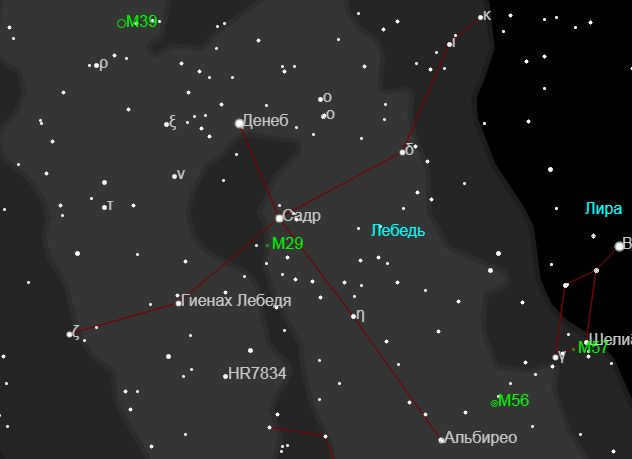
Swan constellation was named after the swan that Zeus transformed into during one of his romantic encounters on Earth.
According to another myth, it represents Orpheus – which is why the constellation Lyra is located nearby.
Swan constellation – diagram
The diagram above illustrates the arrangement of the Swan constellation. As previously mentioned, the primary stars of the Swan constellation form a distinct cross shape in the sky.
It is evident that the “rung” of the cross appears to intersect with the Milky Way, while the cross itself is positioned almost in the center. Hence, the diagram depicting the location of the main stars of the Swan constellation proves to be quite useful during the summer months for easier identification of the Milky Way amidst the illuminated sky.
If one mentally extends the crossbar in both directions within the Swan constellation diagram, a remarkable resemblance to curved swan wings can be observed – the bright stars are remarkably situated at appropriate distances.
The constellation Swan, also known as the “Northern Cross,” is characterized by its regular arrangement of stars in the shape of a cross.
Brightest stars in the Swan constellation
The brightest stars in the Swan constellation include:
– Deneb (α Cyg, Alpha Swan) – a white supergiant with a magnitude of 1.25.
– Sadr (γ Cyg, Gamma of the Swan) – a young pulsating supergiant with a magnitude of 2.23, surrounded by the faint nebula IC 1318.
– Hyenach (Jenach) of the Swan (ε Cyg, Epsilon of the Swan) – a dying giant star with a magnitude of 2.48.
– Delta of the Swan (δ Cyg, Delta of the Swan) – a triple star with a magnitude of 2.87. It is a fairly bright star without a unique name, which is quite rare.
– Albireo (β Cyg, Betta of the Swan) – a well-separated double star in the telescope, with constituent brightnesses of 5.10 and 3.08 magnitudes.
Deneb (α Cyg, Alpha of the Swan) is the most brilliant star in the Swan constellation. It is a supergiant of the blue Class A, positioned approximately 1500 light-years away from the Sun.
Based on the most cautious calculations, Deneb has a luminosity that surpasses 48,000 Suns! (alternative estimations vary from 67,000 to 250,000.) This signifies that Deneb is the most radiant among the 25 most brilliant stars in the firmament – it all boils down to the distance. In a single day, Deneb emits an amount of light equivalent to what our Sun produces in a century and a half, if not more.
If Deneb occupied the position of Sirius, the brightest star in our celestial sphere, its radiance would surpass that of the Moon.
The dimensions of the most luminous star in the Swan constellation are striking: if Deneb were situated at the center of the Solar System, the Earth’s orbit would be in close proximity to the surface of this star.
At present, Deneb is in its final phase of life – based on radiation characteristics, its core has already completed thermonuclear reactions involving hydrogen. Calculations indicate that within the next two million years, Deneb will undergo a supernova event. Fortunately, Deneb is not in close proximity to Earth, but our planet will still be exposed to its radiation dosage.
Sadr (γ Cyg, Gamma of the Swan) is the second brightest star in the constellation Cygnus. It is situated precisely at the intersection of the asterism known as the Northern Cross.
Sadr is classified as an F8 star and has a mass that is 12 times greater than that of the sun.
From the perspective of amateur astronomers, Sadr possesses three notable characteristics:
– There is a faint star with a brightness of 10 m located 142 arc seconds away from Sadr. It remains uncertain whether this star is a companion to Sadr.
– Surrounding Sadr is the diffuse nebula IC 1318, also known as the Gamma Swan nebula or Butterfly nebula. It consists of three components and can only be observed with a good telescope under dark skies.
– Positioned very close to Sadr is the small scattered cluster NGC 6910.
Hyenach (Genach) Swan (ε Cyg, Epsilon Swan) is an orange giant located just 72 light-years away. It should not be confused with another star known as Jenach Raven.
Delta of the Swan (δ Cyg, Delta of the Swan) is a system of three stars. It consists of a giant star with a blue-white color and a class B9 classification. This star has a mass equal to three times that of the Sun. The second star in the system is a dwarf star with a yellow-white color and a spectral class F. It is one and a half times larger than the Sun and orbits at a distance of 84-230 astronomical units from the first star. The third component of the system is an orange dwarf star that is smaller than the Sun. It acts as a companion to the main pair of heavier stars.
Over time, due to the Earth’s precession (the slow rotation of its axis with a period of 26,000 years), Delta Swan will temporarily become the star “Polaris” for a few centuries around the year 11,500.
Albireo (β Cyg, also known as the Swan’s Beta Star) presents a fascinating opportunity for observational astronomers. This celestial phenomenon features a captivating pair of stars, Albireo A and Albireo B, with distinct characteristics. Albireo A is an orange giant star classified as a K spectral type, while Albireo B is a blue star classified as a B9 spectral type. These two stars are in orbit around each other, completing a full revolution every 100,000 years.
One remarkable aspect of Albireo is its visibility to the naked eye or through a telescope, making it a popular target for evaluating the capabilities and settings of telescopes and binoculars.
Furthermore, the contrasting colors of Albireo, with its orange and blue hues, provide an excellent opportunity to assess the equipment’s ability to capture and display colors in astronomical images. Typically, distant objects observed through a telescope appear in black and white, so the chance to observe a colorful image is quite delightful. If Albireo is visible in the night sky, it is unlikely that any amateur astronomer would pass up the chance to observe it, even if just for a few moments.
The Summer Triangle is formed by the brightest star of the constellation Swan, Deneb, along with the stars Vega and Altair. This distinctive cross in the summer sky makes the constellation Swan easily visible. Vega belongs to the constellation Lyra, while Altair belongs to the constellation Eagle.
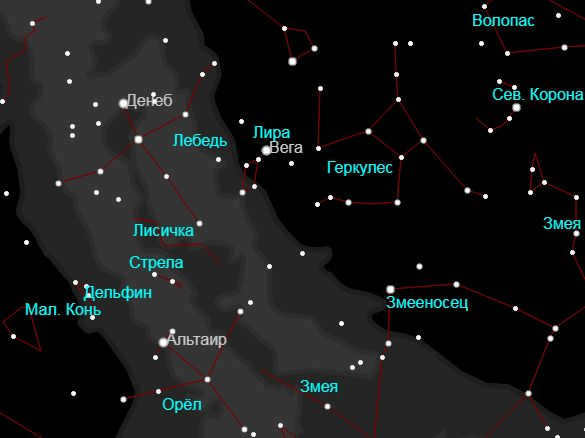
During the month of July, in the central region of Russia, around the time of midnight, the constellation Cygnus comes very close to the point directly overhead. Additionally, the star Deneb is positioned almost directly above you.
As a result, all you need to do is look straight up in order to easily spot the distinct shape of the Cygnus constellation without any further guidance or instructions.
Interesting Facts about the Swan Constellation
Interestingly, when translated from Arabic, the main stars in the Swan constellation represent different parts of a swan’s body:
Hyenach – representing the wing
Sadr – representing the breast (which is the central star of the constellation)
Albireo, representing the beak.
Deneb – representing the tail.
It is peculiar that the relatively bright Delta Swan star does not have its own name.
In Chinese mythology, they didn’t overlook the fact that the “wings” of the Swan constellation intersect the Milky Way. There is a legend in China about a celestial ford or bridge that is formed by these stars across the celestial river.
Interesting Objects in the Swan Constellation
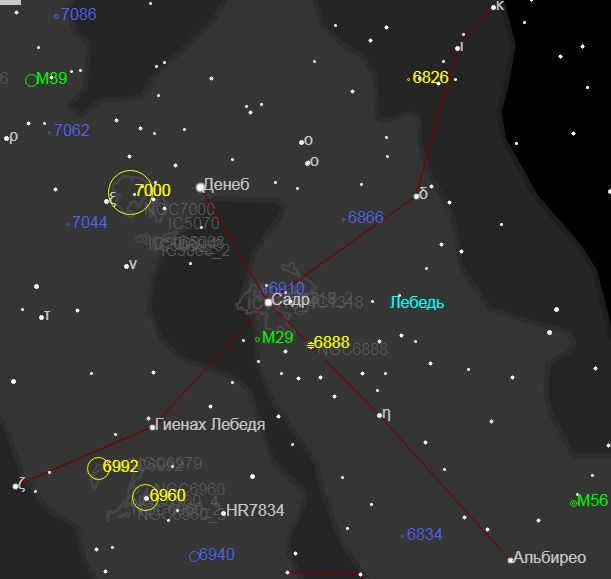
The Swan constellation itself is already stunning, you have already been acquainted with the stars, and now it is time to delve into the nebulae and galaxies that populate the Swan constellation.
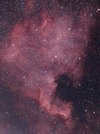
The North American Nebula, NGC 7000, located near Deneb, is perhaps the most well-known object in the constellation Swan.
NGC 7000 can be easily observed with a small telescope and is even visible with binoculars.
However, like all nebulae, it cannot be seen in the night sky of a city.
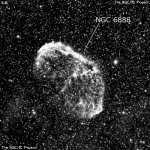
The Nebula NGC 6888, also known as the Crescent Moon, is easily visible and can be found in a straight line connecting the star Sadr to η Swan. It is positioned slightly short of the midpoint between these two celestial bodies.
With a brightness of approximately 10 m, this nebula is quite prominent.
This nebula originated around 400,000 years ago as a result of emissions from the supergiant star HD 192163.
The distance between the Sun and the Crescent Nebula is estimated to be around 4700 light-years.
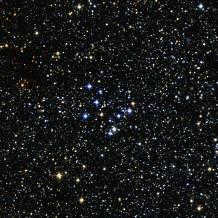
NGC 6960 and NGC 6992 form part of the well-known Fisherman’s Net Nebula (also known as Veil, and sometimes referred to as Loop). This nebula is the result of a supernova explosion that occurred between 5,000 and 8,000 years ago.
It is also worth noting the presence of the globular cluster M56 and the planetary nebula NGC 6826 in the Swan constellation.
The Swan constellation is situated against the backdrop of the Milky Way, so there are very few galaxies visible in this area, with the exception of a few faint ones at the edges, beyond the celestial river. However, even with this limited number, there is still plenty for amateur astronomers to enjoy during the summer observations of the Swan constellation.
Observing the Swan Constellation in the Night Sky
The Swan constellation, also known as the Northern Cross, is easily visible in the sky due to its distinctive arrangement of bright stars. It is classified as a summer constellation, as it reaches its highest point in the sky during this season, making it ideal for observation.
Spotting the Swan Constellation
During the summer months, the Swan constellation can be found in the southeastern part of the sky. It gradually moves southward and remains relatively high above the horizon. Spotting it is a breeze, thanks to the prominent star Deneb, which serves as the alpha star in the Swan constellation. The constellation itself resembles a cross, and in ancient maps, it was often depicted as a swan.
The Summer Triangle
Deneb, apart from being a key star in the Swan constellation, is also one of the vertices of a celestial formation known as the Summer Triangle. The other two vertices are formed by Vega, the alpha star in the Lyra constellation, and Altair, the alpha star in the Eagle constellation. These three stars are among the brightest in the summer sky and serve as excellent reference points for stargazers.
The Swan constellation is positioned against the backdrop of the Milky Way, making it rich in fascinating celestial objects such as stars, star clusters, and nebulae. For any astronomy enthusiast equipped with even a modest telescope, this region offers a plethora of opportunities.
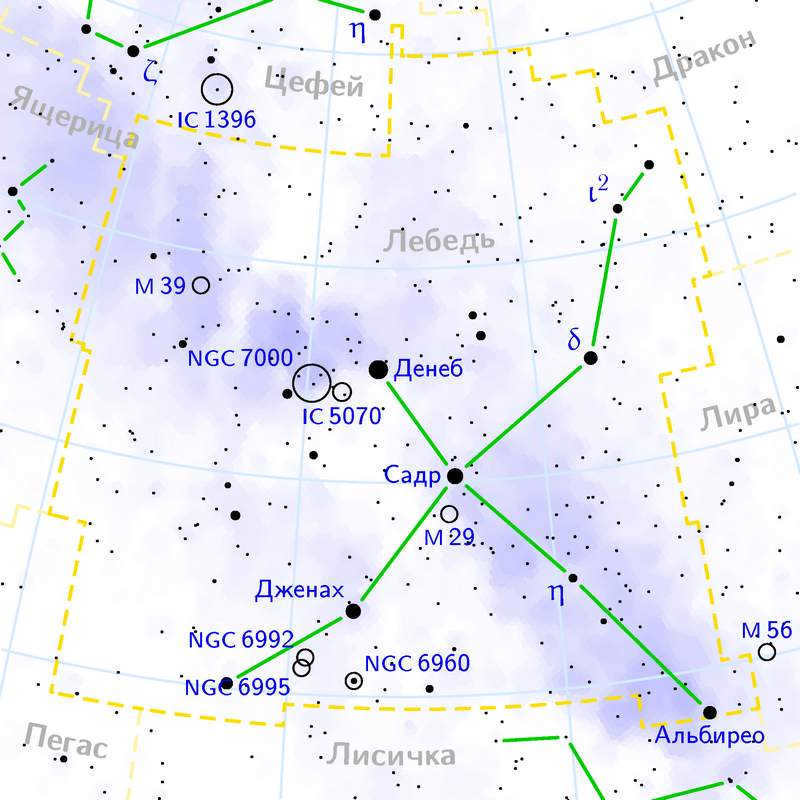
Notable Stars in the Swan Constellation
The Swan constellation is known for its large size and the presence of numerous fascinating stars. One of the most captivating features is the presence of double stars, with Albireo being a prime example. These pairs are exceptionally beautiful and can be easily observed using a small telescope. Each star in the constellation has its own unique characteristics, so let’s take a closer look at some of the most noteworthy ones.
Deneb. The α star of the Swan constellation, shines brilliantly in the vast expanse of the Milky Way. It stands out as one of the most luminous stars in our galaxy. Despite being located 1640 light-years away, its brightness measures +1.25m.
The reason behind this extraordinary brightness, despite its immense distance, is quite straightforward. Deneb is renowned as one of the largest and most powerful stars ever discovered. In fact, the diameter of this colossal white supergiant is comparable to the Earth’s orbit. This means that Deneb is a staggering 240 times larger than our Sun, and it emits a staggering 67,000 times more light! To put it into perspective, the Sun emits the same amount of light in 140 years as Deneb does in just one day.
Similar to other supergiants, the lifespan of the alpha star in the Swan constellation is limited. It has already depleted all of its hydrogen reserves, and in a few million years, it will undergo a cataclysmic event known as a supernova. As you gaze upon this celestial body, reflect upon its astonishing remoteness, while also acknowledging its indescribably radiant brilliance.
Albireo: the Most Stunning Binary Star System
While Deneb gracefully adorns the tail of the Swan constellation, Albireo proudly shines at the tip of its beak. Positioned as the beta star in the constellation, it stands at the opposite end of its “cross”.
Albireo boasts one of the most captivating star pairs in the night sky. Even a modest telescope will reveal the vibrant orange giant, radiating at a magnitude of 3.4m, accompanied by its neighboring blue star, shining brightly at 5.1m magnitude. Their distinct colors are a sight to behold, inviting observers to admire the pair for hours on end. The angular separation between the stars measures at 34″.
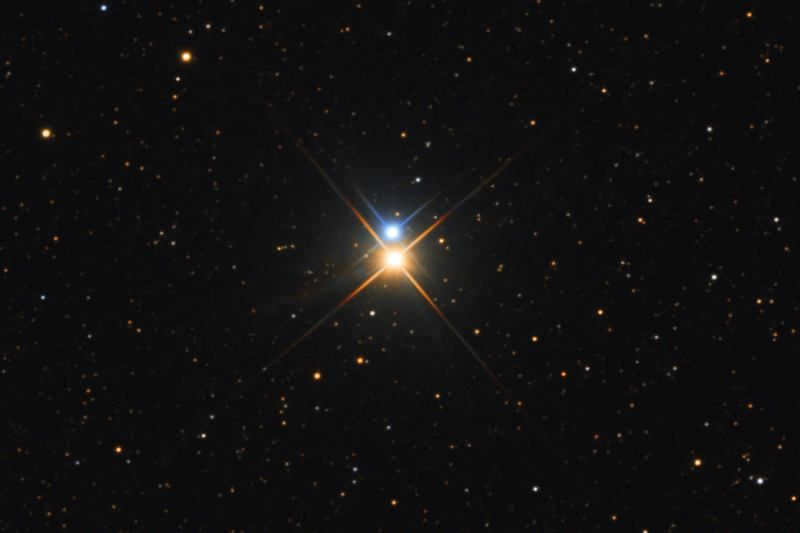
Albireo, the double star, is renowned for its breathtaking beauty.
These two stars are physically linked together and form part of the same celestial system, revolving around a shared center of mass over the course of approximately 100,000 years – such is the vastness of the space between them.
Interestingly, this particular star is actually a triple star. The orange giant has an additional blue companion, although this pair is situated so closely together that they cannot be distinguished from each other when observed through a telescope. The distance to this captivating system is approximately 385 light years.
A short distance away from Deneb, an intriguing binary star system known as 61 Cygni can be observed. This stellar pair consists of two orange dwarf stars, each significantly smaller than our Sun. Completing a full orbit every 678 years, these stars can be distinguished even with a small telescope. While visible to the naked eye, their faintness makes it preferable to use binoculars for optimal viewing.
61 Cygni is notable for its historical significance. Situated just 11 light-years away, it is considered relatively close to our solar system. Its apparent motion across the sky was first recorded by Italian astronomer Giuseppe Piazzi in 1804, making it one of the earliest stars to have its distance accurately measured. This discovery further supported the concepts of the cosmic order proposed by Giordano Bruno.
This celestial body acquired the moniker “The Flying Star” due to its rapid motion.
During the 1950s and 1970s, the star known as 61 Cygni garnered considerable attention. Some observations indicated deviations in its trajectory, which were attributed to the presence of multiple planets with masses comparable to Jupiter. At that time, the discovery of planets around other stars was purely theoretical, making this finding a true sensation. However, subsequent investigations failed to confirm these claims, and modern instruments have not detected any exoplanets orbiting 61 Cygni, though a dust disk is thought to be present.
If you happen to direct your telescope towards the constellation of Cygnus, be sure to take a glimpse of this intriguing star. It has even made appearances in works of science fiction, adding to its notoriety. Truly a stellar pair.
Nebulae and clusters in the constellation Cygnus
The constellation Cygnus is home to a multitude of fascinating nebular objects. Within this constellation, one can find an abundance of star clusters and nebulae that are truly breathtaking. While some of these celestial wonders can be observed with just a pair of binoculars, others require the use of a high-powered telescope. In this article, we will highlight the most prominent and noteworthy nebulae and clusters in Cygnus.
M 29 is a star cluster that appears scattered
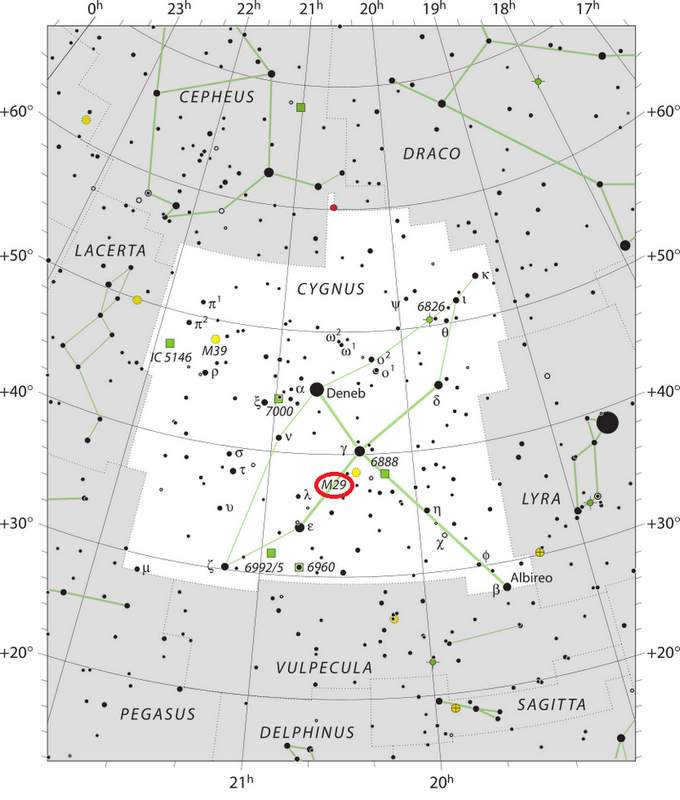
This celestial object is known as NGC 6913 and is situated in close proximity to the luminous star γ Swan. With a magnitude of 7.1m, it cannot be seen with the naked eye, but can be easily observed with binoculars. A telescope, even a small one, will reveal the full splendor of M 29. However, for optimal viewing, it is recommended to use a telescope with a diameter of 150mm or larger.
Consisting of approximately 50 stars, this cluster showcases a distinctive arrangement, resembling both a quadrangle and a triangle. Due to its shape, it is commonly referred to as Gradirnia.
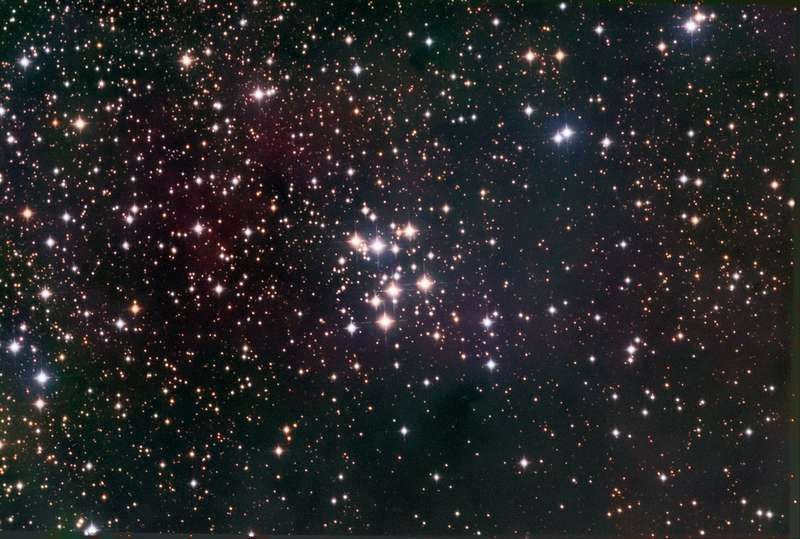
The constellation Cygnus contains a scattered star cluster known as M29.
M29 is located approximately 4000 light-years away and has a size of about 11 light-years. Interestingly, it is moving towards us at a speed of 28 km/s. However, due to the presence of a significant amount of dust and gas between us and the cluster, the stars of M29 appear dimmer to observers on Earth than they actually are. This is particularly true for the cluster’s hot giants, which are affected the most by the intervening material.
M 39 is an impressive diffuse cluster
This cluster, with a brightness of 4.2m, can be effortlessly spotted with the naked eye. In Swan, it holds the title of the brightest. Even with 10x binoculars, M 39 appears stunning and remarkable. It is located 820 light years away from our planet, and when observing the constellation, make sure to search for it – it is situated relatively close to Deneb.
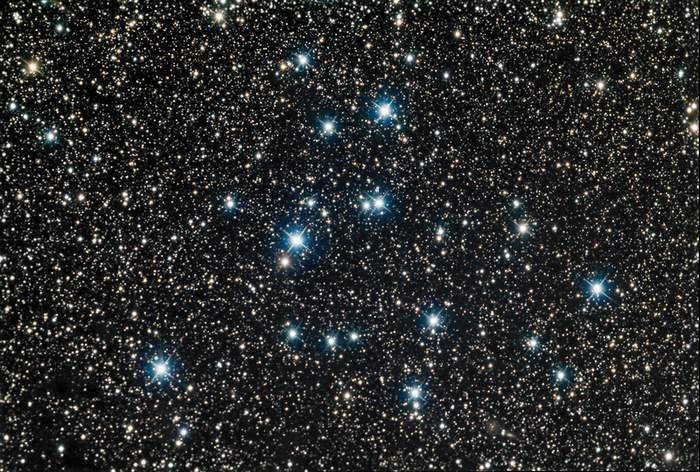
Scattered star cluster M39.
NGC 6811 is a dispersed group of stars
This particular group of stars has a magnitude of 6.8m and can be easily spotted using binoculars. However, the brightest stars within the cluster have a magnitude of 9.8m, requiring a small telescope to distinguish them. At first glance, the cluster appears to be a small collection of stars, but this is a misleading impression. In reality, it is a very populous cluster, containing over 1000 stars. Most of these stars have a magnitude greater than 15m, making them inaccessible to amateur telescopes.
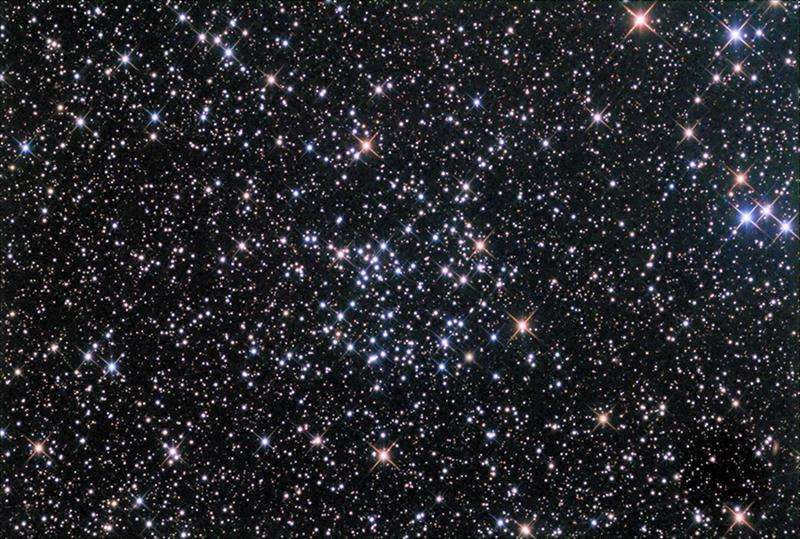
The star cluster NGC 6811 is scattered across a vast distance of 3300 light years. What makes this cluster particularly intriguing is the lack of stars in its center, with the majority of stars being concentrated around it. The reason for this empty center remains a mystery, making NGC 6811 a subject of close examination for the Kepler space telescope.
The Veil Nebula – NGC 6960.
NGC 6960, commonly known as the Veil Nebula, is an incredibly stunning diffuse nebula captured in photographs. Its captivating appearance has earned it alternative names such as the Fisherman’s Net and the Witch’s Broom, as it bears a striking resemblance to both.
This remarkable nebula is the remnants of a supernova that occurred several thousand years ago. Today, it exists as a colossal cloud of gas spanning over 50 light-years. Its immense size is evident as it occupies an impressive 3 degrees in the field of view, and some of its brightest sections have been designated with their own names in various catalogs. The most prominent segment is referred to as the Veil.
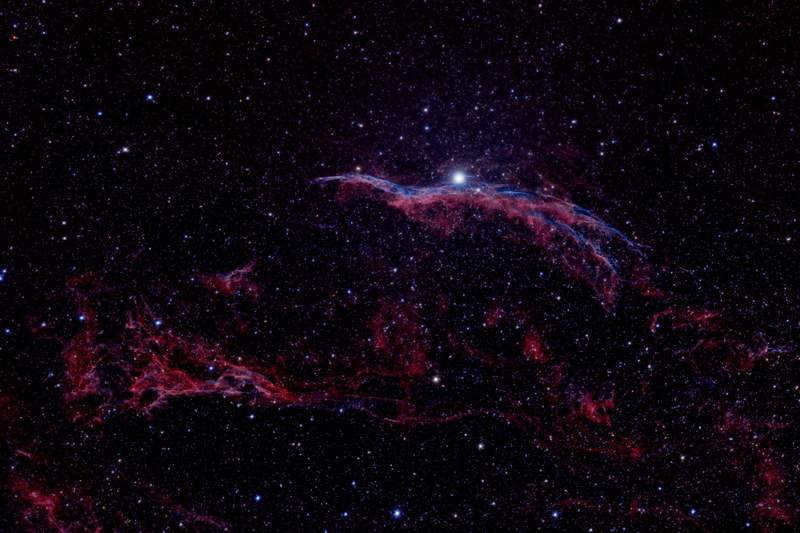
The Veil Nebula can be found in the constellation Cygnus.
The star 52 Cygnus, which has a magnitude of 4.2, can be used as a guide to locate the nebula. However, it is a challenging object to observe visually with amateur telescopes. To detect it against the background of the sky, narrow-band light filters and a large aperture are required. Nevertheless, it appears stunning in photographs.
Equally remarkable are other segments of this nebula, namely NGC 6992 and NGC 6995.
Undoubtedly, the enumerated clusters, the allurements of the Cygnus constellation, are not fully explored. There are numerous additional clusters and nebulae within it, albeit they present as considerably more challenging subjects to observe even with high-powered amateur telescopes.
As an illustration, a remarkably striking nebula exists in the Cygnus constellation, NGC 7000, known as the “North America.” In the image, it genuinely resembles the shape of this continent. Its magnitude is 4m, but when scrutinized through binoculars or a telescope, visibility is quite limited. However, photographs taken with the application of filters yield rather satisfactory outcomes.
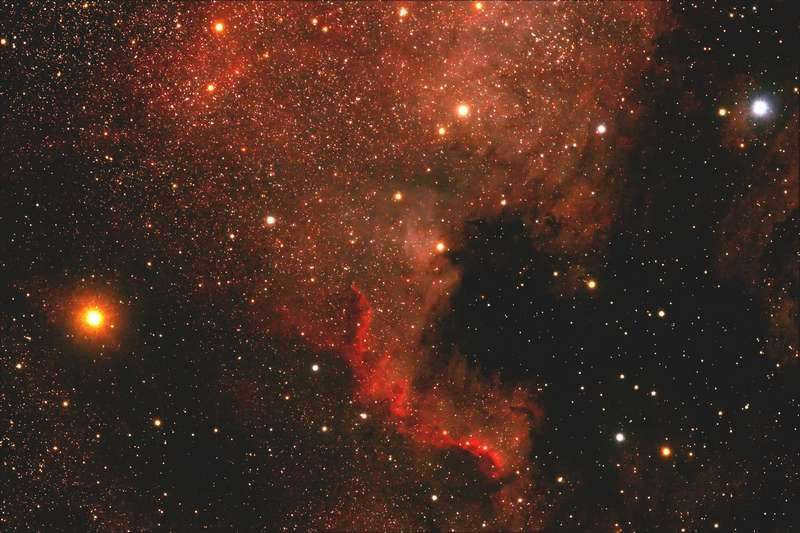
The Nebula North America bears a striking resemblance to the continent of the same name.
Called the Flickering Nebula, the planetary nebula NGC 6826 is known for its unique optical properties. When observing the central star directly, it appears invisible. However, when viewed from a different angle, the nebula becomes visible. It is recommended to observe NGC 6826 using a telescope with an aperture of at least 130 mm and to use light filters if possible. The nebula has a brightness rating of 8.6m and measures 0.6 arcminutes in size.
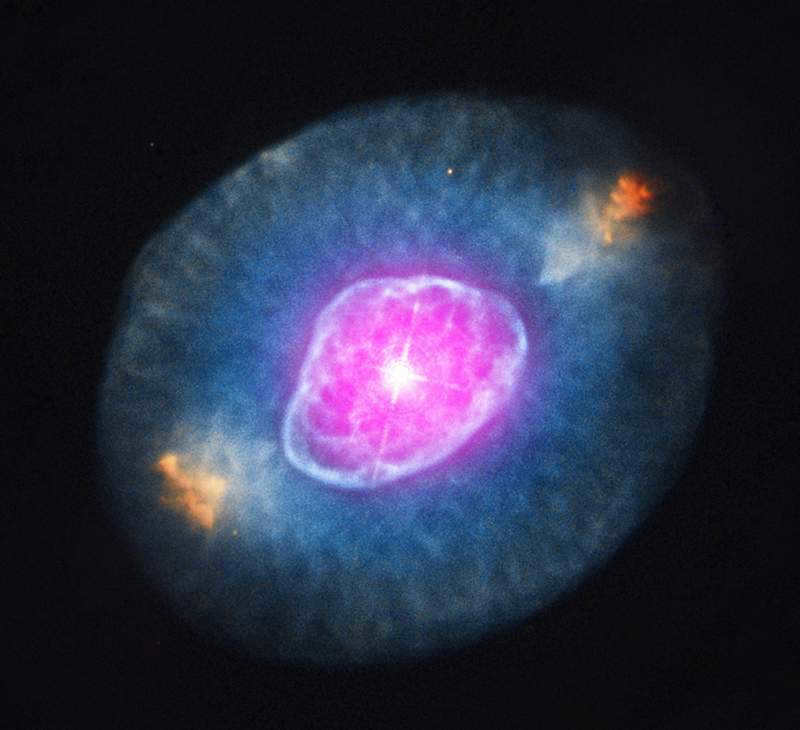
A photo taken by the Chandra telescope shows the beautiful planetary nebula NGC 6826.
NGC 6884 is another planetary nebula that is much smaller and less bright than the Ring Nebula in Lyra. It has a magnitude of only 10.9m and requires a 300mm telescope to observe.

The celestial object NGC 6884 is a stunning example of a planetary nebula located in the constellation Cygnus, also known as the Swan.
In the same constellation, there is another captivating planetary nebula called NGC 7008. This celestial beauty, although visually appealing in photographs, requires a telescope with a minimum aperture of 250 mm for optimal observation.
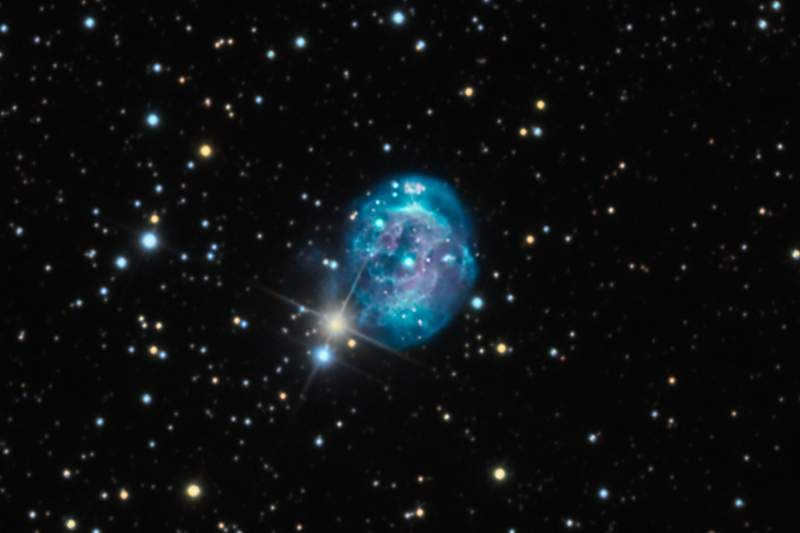
The planetary nebula NGC 7008 is known for its unique characteristics.
Another well-known object is the reflection-emission nebula IC 5146, which is often referred to as Cocoon. This nebula has a brightness measurement of 7.2m and occupies a space of 10'x10'. Although the central star, with a brightness of 9.7m, can be observed with a small telescope, the nebula itself becomes visible only when light filters are used. Interestingly, there is a dark dust nebula that surrounds this gas nebula.
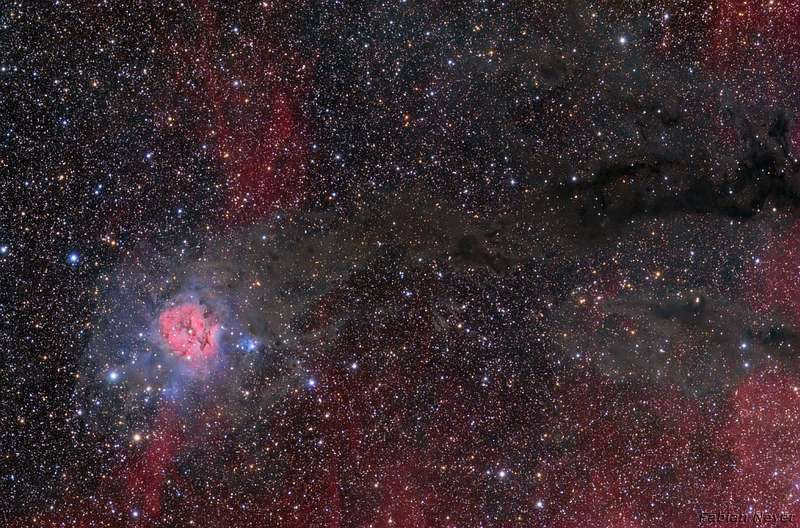
The Cocoon Nebula is surrounded by a dark dust nebula.
Despite being mostly located in the background of the Milky Way, the Swan constellation offers more than meets the eye, including galaxies. One such galaxy is the stunning spiral galaxy known as NGC 6946, or “Fireworks.” It appears flat when observed from our perspective, but it boasts a surface brightness of just 14m at 9m, requiring a minimum telescope size of 150mm to be visible.
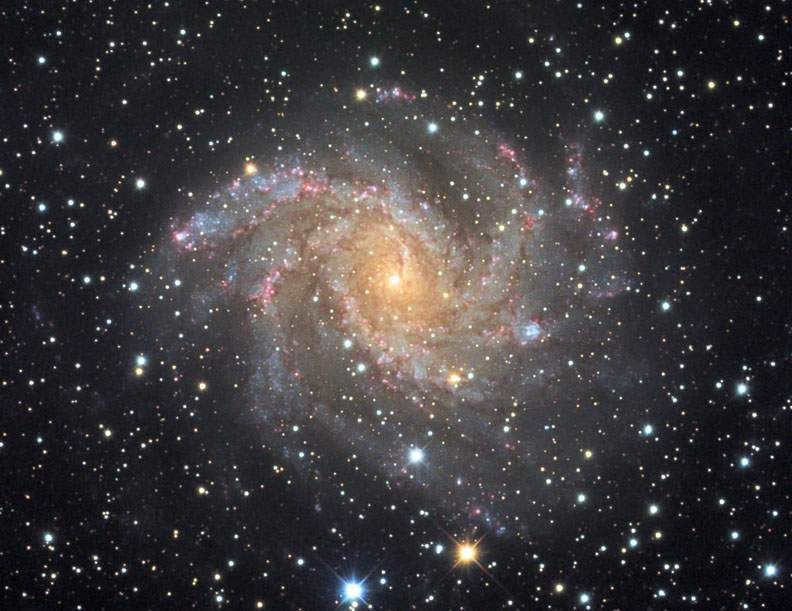
The Firework Galaxy, also known as the galaxy NGC 6946, is a stunning sight to behold.
The Swan constellation offers a wealth of wonders, although not all can be easily observed with amateur telescopes. However, those with a 150mm instrument or larger can explore a wider range of celestial objects. Owners of 200mm and larger apertures can discover not only the objects mentioned here, but also numerous others that may be more challenging to observe. To aid in their search, the planetarium software “Stellarium” can be utilized, and some objects are marked in an atlas that can be downloaded and printed.
We hope you have clear skies and an exhilarating journey through the Swan constellation!
Test your focus
Can you identify the prominent stars at the focal point of the image displayed? Kindly share your response in the comment section.
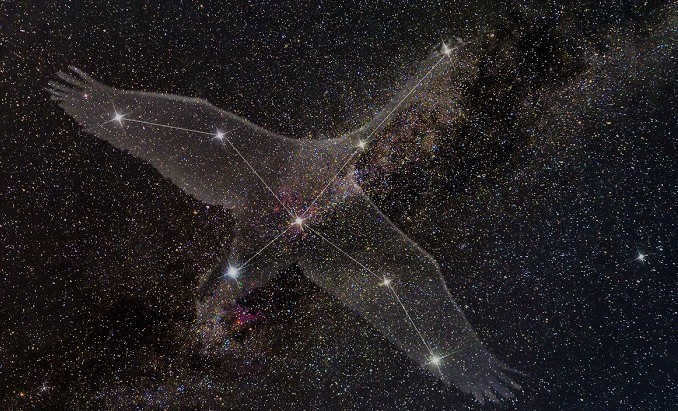

The constellation known as the Swan was originally discovered by the ancient astronomer Ptolemy in the 2nd century. It is a beautiful formation that stretches along the expanse of the Milky Way. The Swan is represented by 8 bright stars that create the shape of a bird, complete with a long neck and wide-spread wings. In the center of this celestial formation, there are intersecting objects that form a distinct pattern known as the Northern Cross asterism.
This magnificent cluster covers a significant portion of the night sky, occupying an area that is equivalent to 804 square degrees. It has a unique polygonal shape composed of 28 segments. When gazing at the Swan with the naked eye, one can observe a total of 268 stars, each with varying degrees of brightness.
Observing the Swan:
- The Swan is one of the most prominent constellations in the night sky, and it can be easily located by using the Milky Way as a reference point. During the summer season, the Swan reaches its highest point in the sky and moves from the southeast to the south.
- The Swan is visible in latitudes ranging from +90 to -30.
- The optimal time to observe the Swan is on the night of July 29th.
- To perform a quick search, you can imagine a line connecting Beta Cassiopeia to Gamma and then extending to the top of the Northern Cross.
- The Swan constellation is visible all night long in latitudes above the 60th parallel.
The primary stars include.
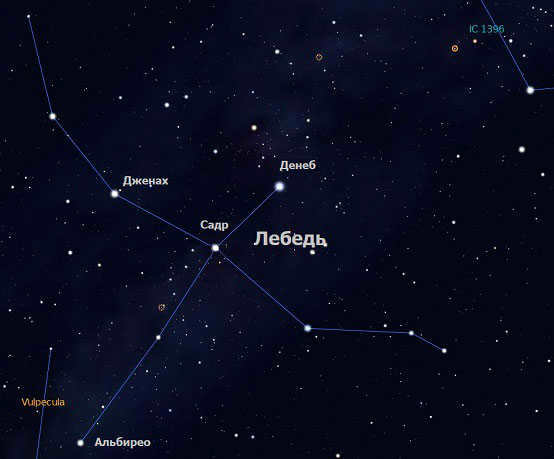 Deneb (Alpha of the Swan).
Deneb (Alpha of the Swan).
Deneb is the brightest celestial object in the Swan constellation. It emits more light in a single Earth day than the Sun does in 140 years.
The exact distance to Earth is still undetermined, so estimates of its brightness range from 60,000 to 250,000 times that of the Sun. It is ranked among the top 25 stars with the highest luminosity known to science.
| Visible stellar magnitude | 1.25 |
| Absolute stellar magnitude | -6.95 |
| Radial velocity(km/s) | -4.5 |
| Rotation(km/s) | 21 |
| Temperature(K) | 8550 |
| Luminosity | Up to 250,000 solar luminosities. |
Deneb is a massive blue-white giant of type A2. It experiences constant movement on its surface, with different regions expanding and contracting randomly. The star’s luminosity can be significantly altered by particularly active pulsations.
The core of Deneb is nearly depleted of hydrogen, and it is gradually cooling down and transitioning into a red supergiant known as Alpha Swan.
Deneb, along with Vega (Alpha Lyrae) and Altair (Alpha Eagle), create the well-known triangle of stars in the autumn and summer months in the northern hemisphere. This stellar formation is visible during the summer and fall seasons.
Albireo (Beta)
Albireo is the fifth brightest star in the Northern Cross constellation. It is a binary star system consisting of two components: Albireo A, an orange giant, and Albireo B, a blue star. Additionally, Albireo A is also a binary star.
| Visible stellar magnitude | 3.08/5.10 |
| Absolute stellar magnitude | -2.28/-0.26 |
| Radial velocity(km/s) | -24.0 |
| Temperature(K) | 4,300/12,100 |
| Luminosity | 950/190 solar |
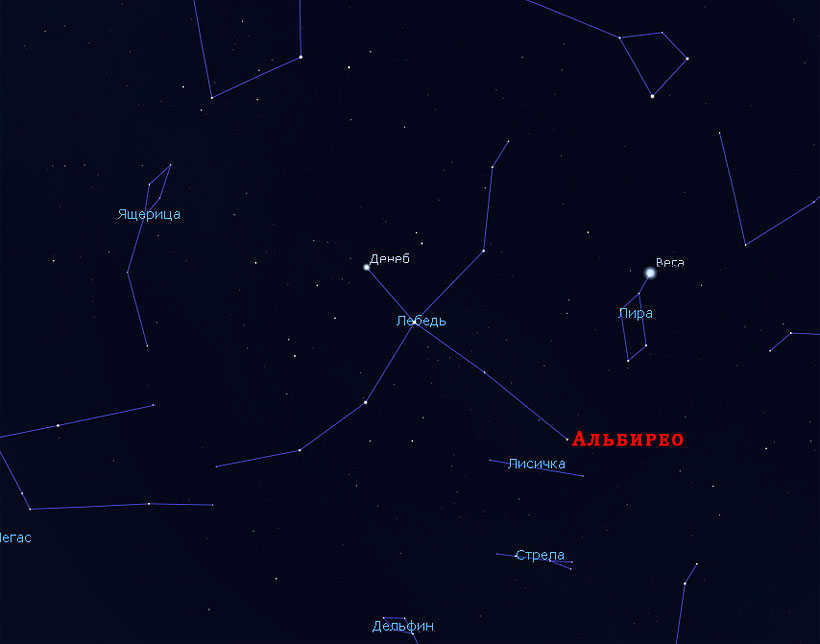
Albireo A is a giant star classified as K211. Its unique color is a result of its relatively low surface temperature of 4000 degrees Celsius.
Albireo B, on the other hand, belongs to the B8V class and is significantly smaller than its companion star, but still three times larger than the Sun. Similar to other hot celestial objects, it has an incredibly fast rotation speed. Matter near its equator can reach velocities of up to 250 km/sec.
Albireo’s distinct colors make it a popular subject for observation. You don’t need professional equipment to observe this double star system; an amateur telescope will suffice.
The Swan Delta is located approximately 170 light-years away from Earth. This celestial system is visually paired, but it actually consists of three distinct objects. The first two stars are closely positioned to each other, while the third star is situated at a significant distance.
| Visible stellar magnitude | -2.87 |
| Absolute stellar magnitude | -0.63 |
| Radial velocity (km/s) | -20.1 |
| Rotation speed (km/s) | 135 |
| Luminosity | 155 times that of the Sun |
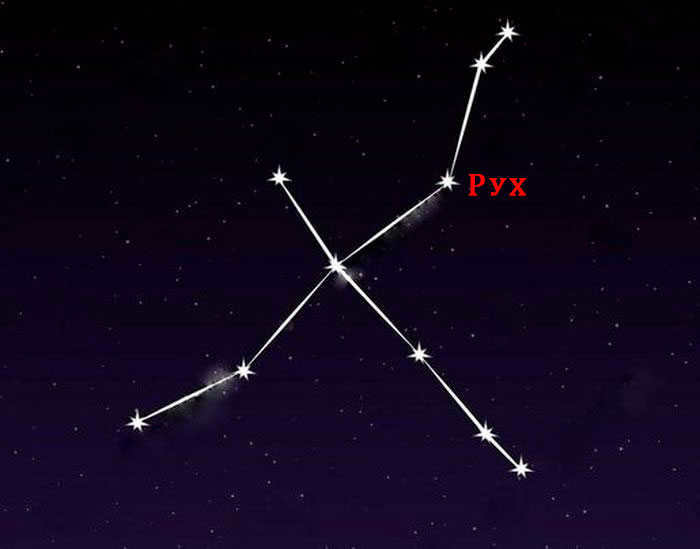
The primary star of the constellation is a massive blue-white giant classified as type B9. It rotates rapidly and emits a hot temperature of 10,500 K, making it three times more massive than our Sun.
Adjacent to the primary star is a white-yellow dwarf, which shines six times brighter than our own Sun. The third star in this constellation is a relatively faint orange dwarf.
For the past four centuries, Rukh has served as a crucial point of reference for travelers and has been regarded as the guiding star.
Sadr (Gamma)
Sadr (Gamma) is the second brightest object in the constellation and is located 1800 light-years away from Earth.
| Apparent stellar magnitude | 2.23 |
| Absolute stellar magnitude | -6.12 |
| Radial velocity(km/s) | -7.5 |
| Rotation(km/s) | 20 |
| Temperature(K) | 6500 |
| Luminosity | 65,000 kelvin. |
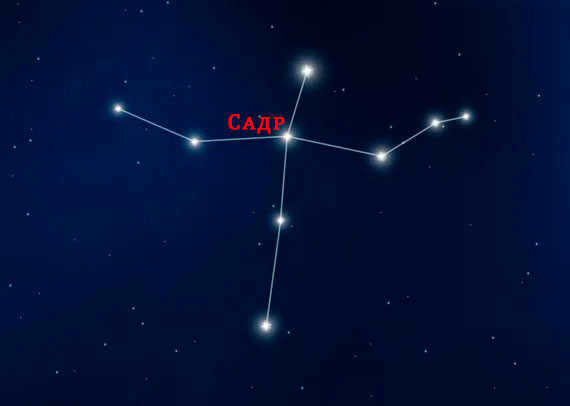
The constellation Swan, also known as Gamma Swan, came into existence approximately 12 million years ago. It is classified as a supergiant star of the spectral class F8. Recent observations have detected pulsations occurring on its surface, with an average period of 74 days.
Similar to other massive celestial bodies, Gamma Swan is currently depleting its nuclear fuel supply at a rapid rate. There is a possibility that it has a companion of medium size.
In Arabic, the name Sadr translates to “breast”. This star is positioned in the center of an imaginary swan formation within the constellation.
Epsilon of the Swan, a dazzling and immense celestial body, boasts an astonishing age of approximately 1.5 billion years. Situated a staggering distance of 73 light-years away from our dear planet Earth, this magnificent star captivates astronomers and stargazers alike.

| Visible stellar magnitude | 2,480 |
| Absolute stellar magnitude | +0.78 |
| Radial velocity(km/s) | 12,40 |
| Rotation(km/s) | 3.0 |
| Temperature(K) | 4,700 |
| Luminosity | 62 solar |
Swan Epsilon is an enormous red giant star with a classification of K0. It used to be a regular white star, but now it has reached the final phase of its evolution. In a few tens of millions of years, Swan Epsilon will exhaust all the helium in its core and collapse in on itself.
There is a possibility that Swan Epsilon has a companion with an orbital period of 15 Earth years.
Fascinating items
Fireworks Spiral galaxy.
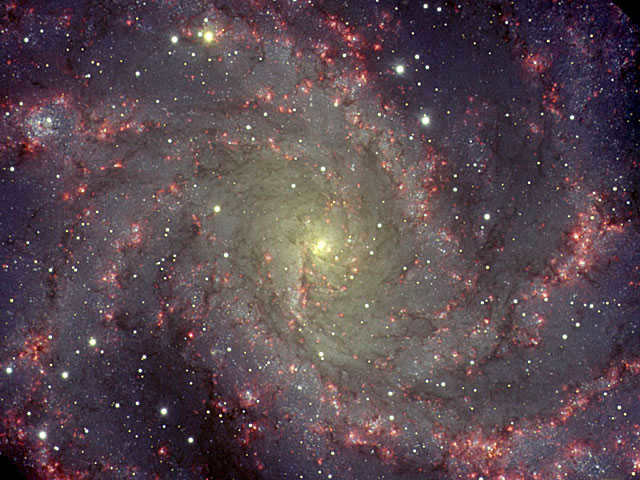
The Fireworks galaxy is situated on the outskirts of the Swan constellation, in close proximity to Cepheus. The name was chosen with purpose as Fireworks is abundant in gas, which plays a vital role in the formation of stars. Over the past century, a remarkable total of 9 supernovae from celestial bodies have been documented in this galaxy. The cluster’s high concentration of ionized hydrogen contributes to the presence of intensely luminous regions.
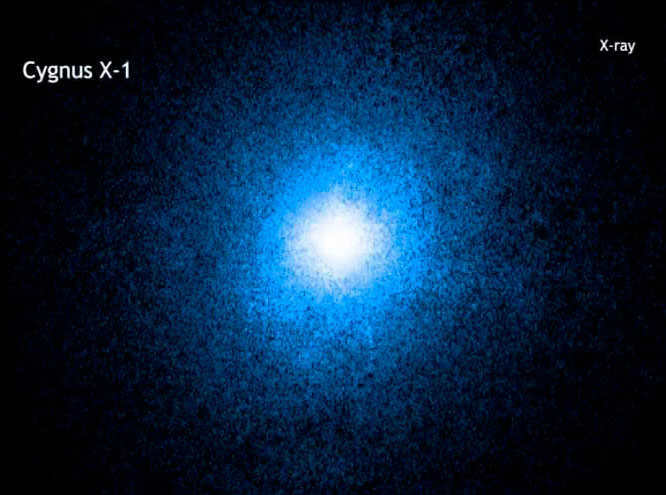
The Swan X-1 is a highly potent source of X-ray emissions. It came into existence approximately 5 million years back. It is believed to be a stellar mass black hole, weighing almost 15 times that of our Sun. This celestial body is a component of a binary system, alongside a blue supergiant, whose stellar wind has a direct impact on the generation of X-rays.
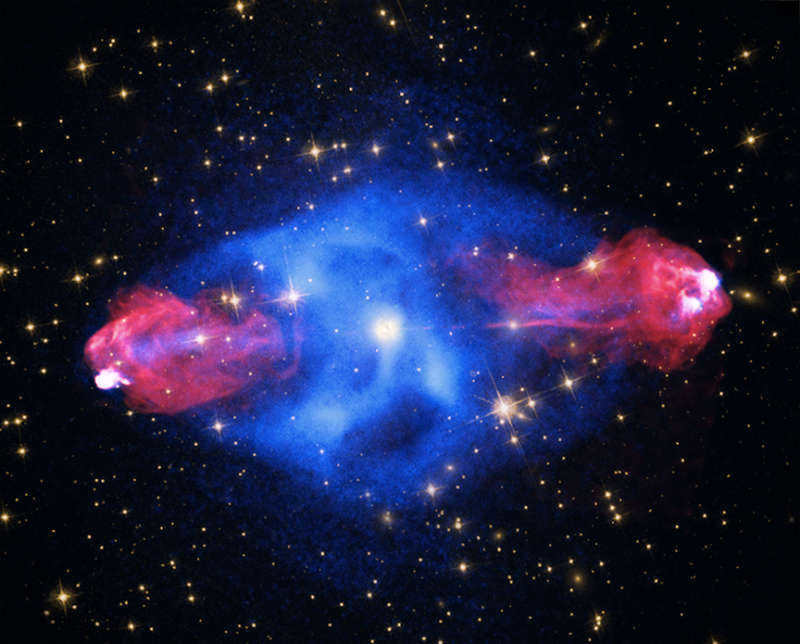
Swan A radio galaxy
Swan A was the initial radio galaxy to be discovered. It was uncovered by Grote Reber in 1939. Despite its significant distance from Earth (600 million light years), Swan A remains the most brilliant extragalactic radio source examined.
By comparing the disparity between its emissions and the power of Andromeda, scientists were able to establish a new categorization that divides galaxies into radio and regular galaxies.
Nebulae
- North America Nebula – Derived its name due to its shape resembling the mainland. It is located approximately 1,800 light years away from Earth. A significant portion of its composition consists of ionized hydrogen, which contributes to the formation of new stars.
- Pelican Nebula – Adjacent to the North America Nebula, it is also a part of their shared star-forming region. Its distance from Earth is approximately 2,000 light years. Within the nebula, there are continuous interactions between stellar radiation and gases.
- The Coal Sack Nebula – Situated 600 million light years away from Earth, it occupies the southeastern corner of the Southern Cross constellation. It is one of the most prominent dark nebulae and can even be observed with the naked eye. True to its name, The Coal Sack Nebula appears as a nearly black spot in the sky.
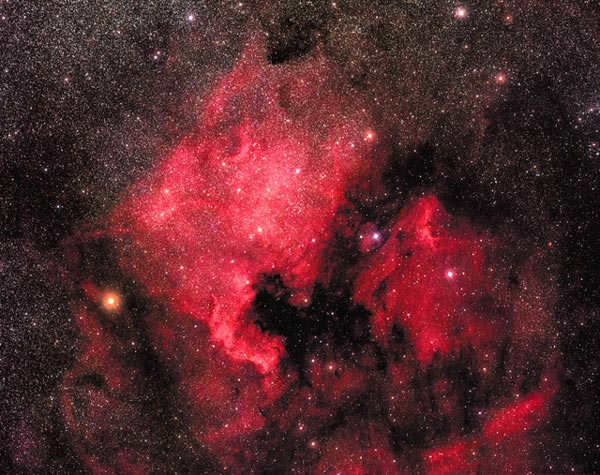
The Swan Constellation
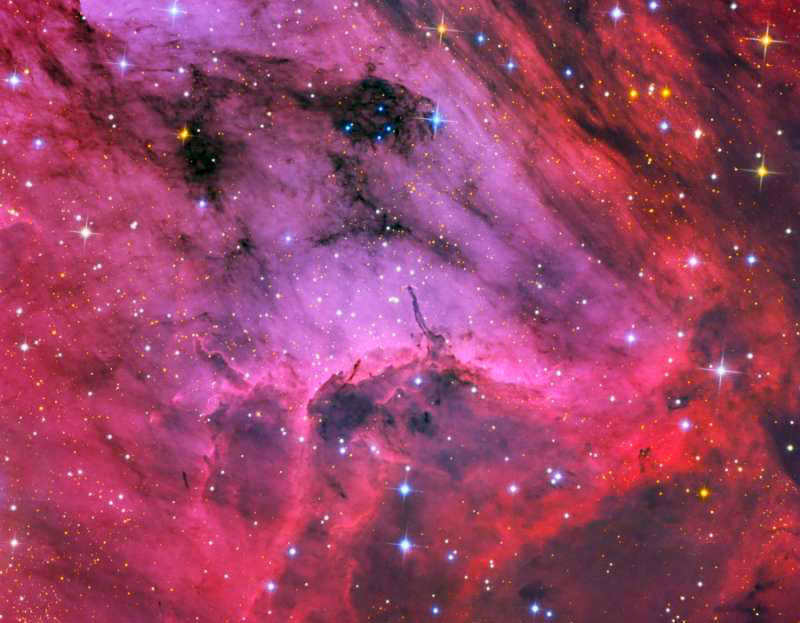
Exploring the Stunning Pelican Nebula
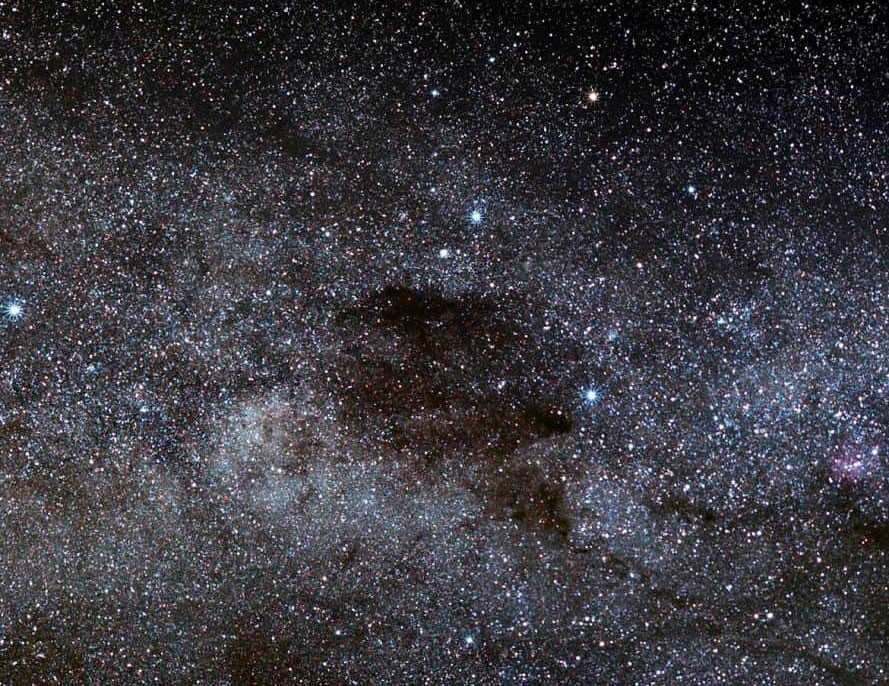
The Coal Sack Nebula
Origin of the name
Cygnus (swan) is the designation given by Claudius Ptolemy in his celestial atlas. According to mythology, the swan represents Zeus transforming into a graceful bird to approach a stunning maiden. To avoid scaring the stranger, the god of thunder took the form of a beautiful swan. In another legend, the constellation is associated with Orpheus, the embodiment of artistic beauty.
The swan is an intriguing celestial entity, concealing numerous extraordinary stars, galaxies, and nebulae. It captivates the attention not only of professional scientists but also of amateur astronomers.
Common Questions and Answers
Based on popular beliefs, it is believed that the Northern Cross constellation plays a significant role in the spiritual growth and development of the planet’s inhabitants.
Adjacent to the Dragon, Cepheus, Vega, and Pegasus, you can find the Swan constellation.
Out of the 88 constellations, the Swan constellation holds the 16th position in terms of its size. It is considered to be a rather large celestial object.
There are five prominent stars that are considered to be the main components of the Swan constellation: Deneb, Albireo, Sadr, Jenah, and Delta.
The word “Swan” in Arabic translates to “tail,” which reflects the star’s position within the celestial arrangement.
A video summary of scientific discoveries regarding the constellation
During a balmy summer evening, when the grey, glistening ribbon of the Milky Way stretches across the expanse of the sky, spanning from one horizon to the other, a truly magnificent bird from the celestial realm can be observed soaring high above, nearly reaching the zenith. This celestial marvel is none other than the constellation of the Swan, arguably the most easily identifiable among the 88 constellations that adorn the heavens.
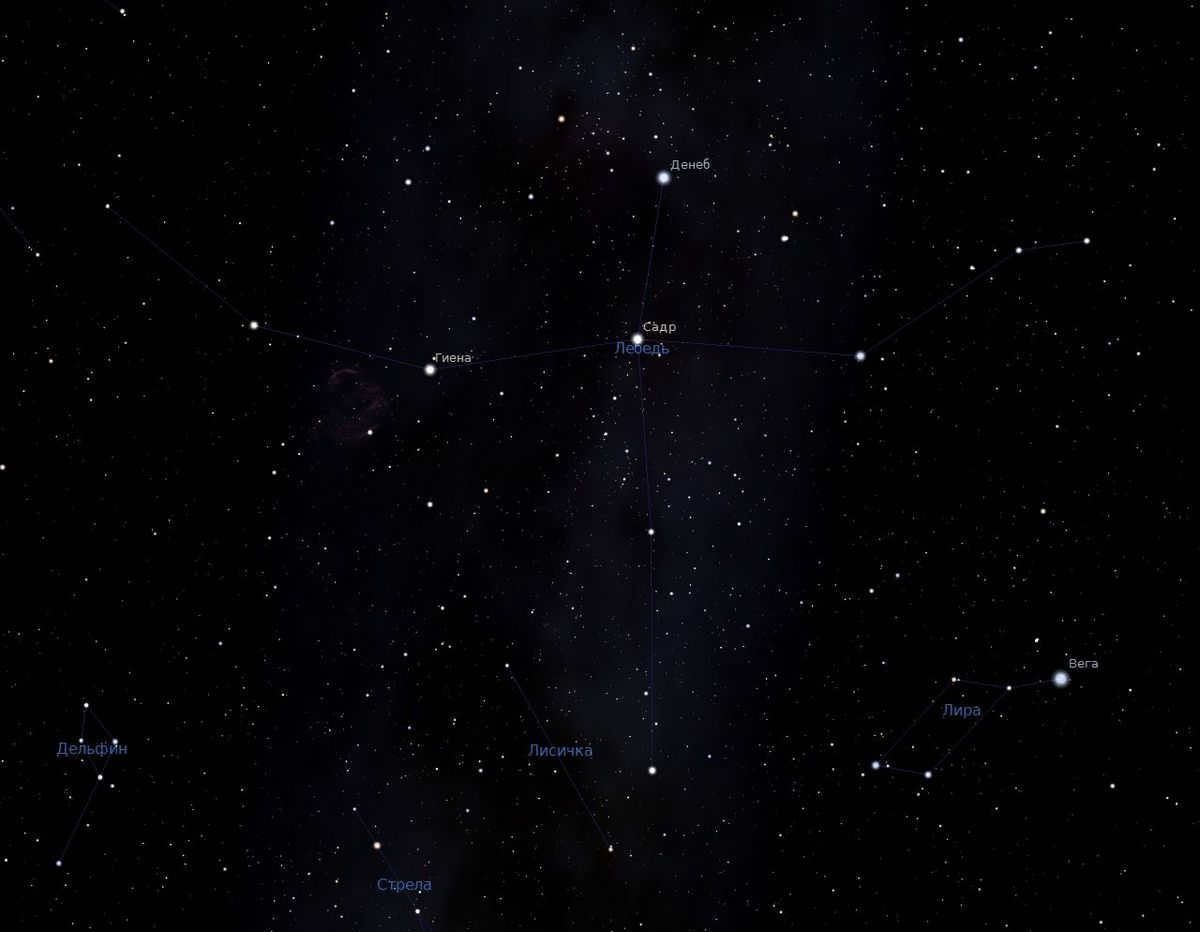
Swan – a screenshot taken from the planetarium software
For the mid latitudes of the Northern Hemisphere, the Cygnus constellation, also known as the Swan, is a semi-circumpolar constellation, meaning that it never fully sets below the horizon. The brightest star in the constellation, Deneb, is always visible. The optimal time to observe the Swan constellation is during the middle of summer.
The primary celestial bodies of the constellation
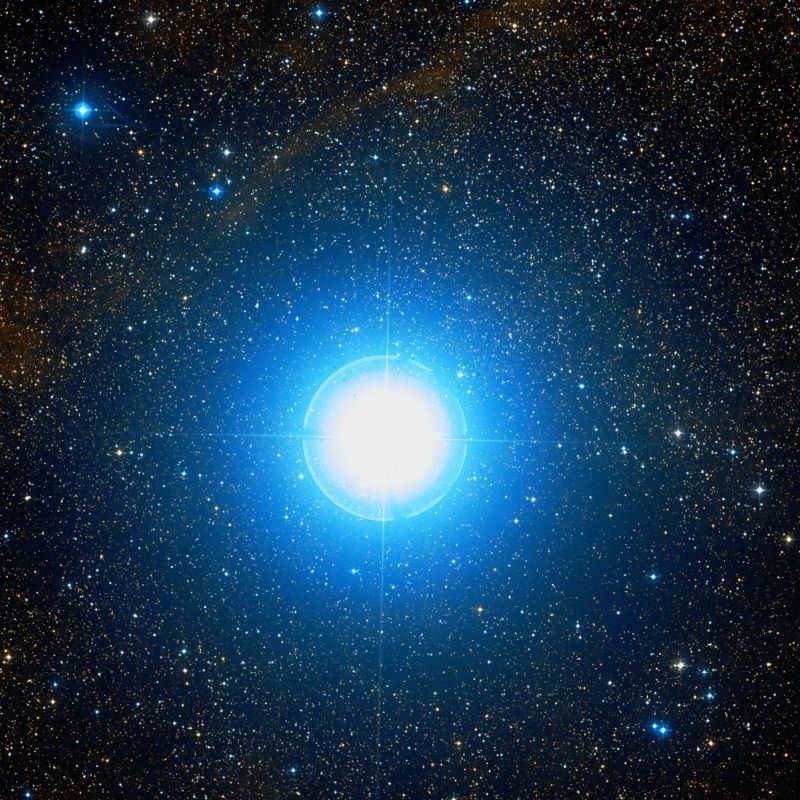
One can easily spot the initial stars, which create a distinct cross (occasionally referred to as the Northern Cross, an outdated term for the constellation). These stars, namely α, β, γ, δ, and ε Cyg, are the most luminous ones in the constellation, with Deneb (α Cyg) leading the way.
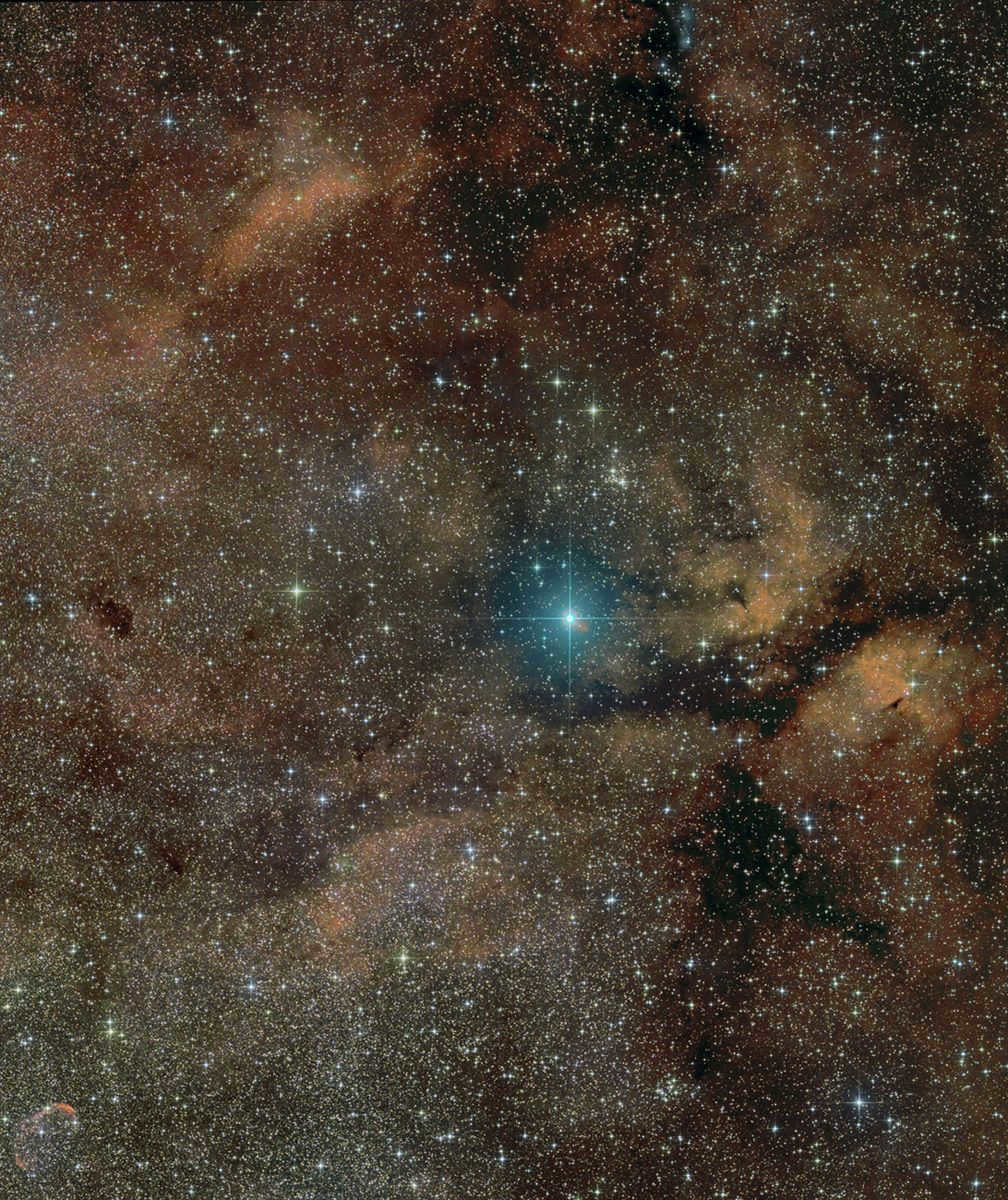
Picture of the enormous star γ in the constellation of Cygnus
When combined with the stars ζ and ι Cyg, the aforementioned five stars create the iconic shape of the bird flying southwest.
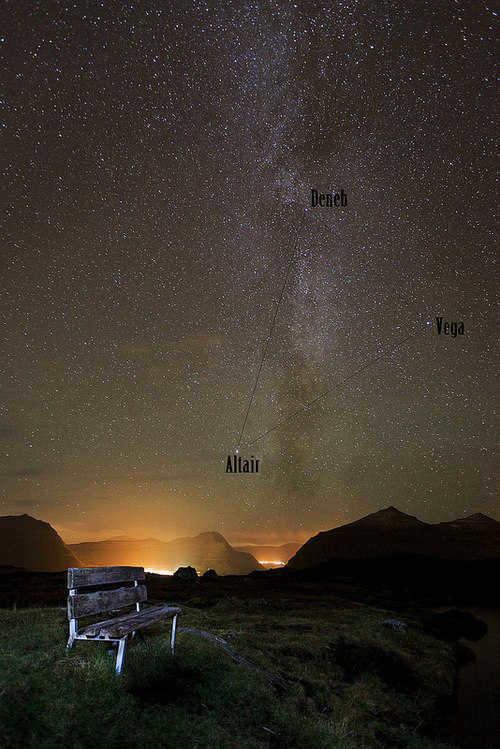
Photograph of the Summer Triangle as seen from the Faroe Islands
In addition, the Summer Triangle is formed by Deneb, along with the nearby stars Altair (α Eagle) and Vega (α Lyra). Deneb, the star at the head of the Swan, is a blue-white star that is over 100 times larger than our Sun and has a visible brightness of 1.25 magnitudes.
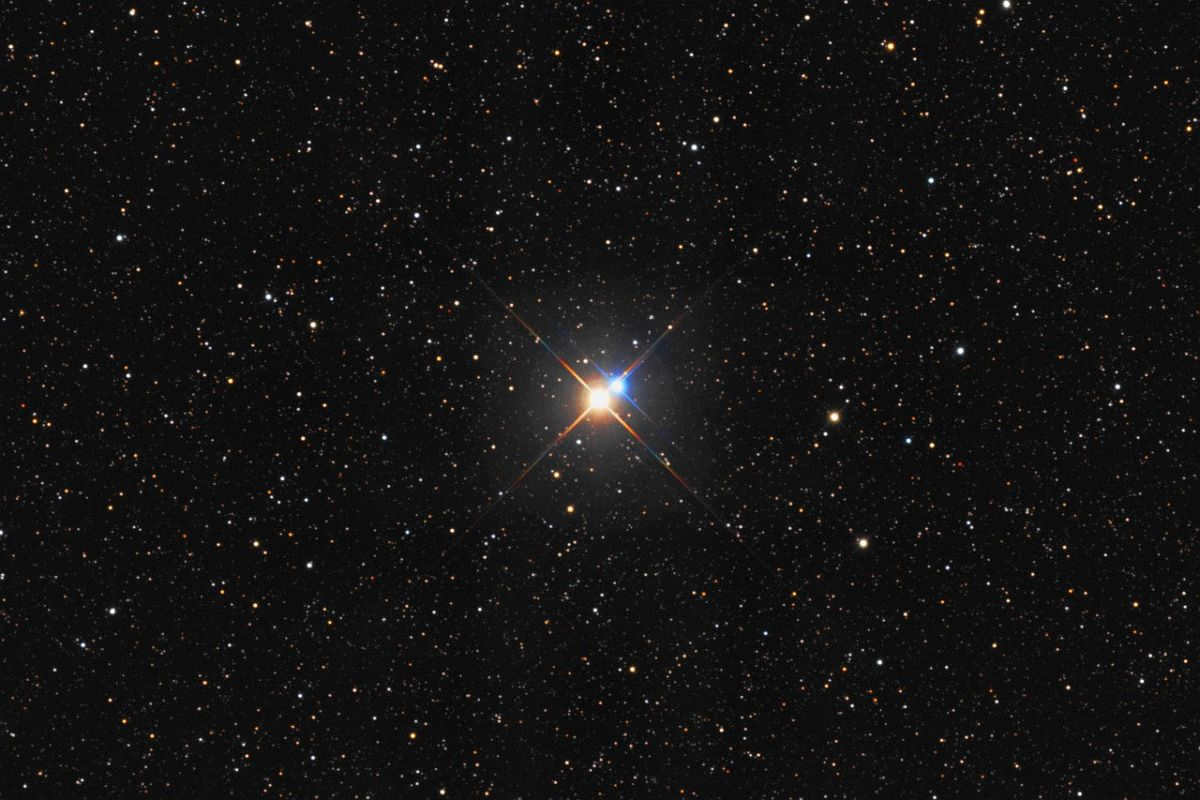
Photograph of Star Albireo or Beta Swan
Arguably the most exquisite star, despite not being the brightest, in the constellation of Swan lies Albireo (β Cyg). It is a binary star system with a separation of 34″ between its components. Albireo A boasts a magnitude of 3.4 and is an orange giant, while Albireo B is slightly dimmer with a magnitude of 5.1. The B component is a blue star. When observed through a telescope, this system is truly breathtaking. The contrast in colors is awe-inspiring. Albireo can be distinguished even at magnifications as low as 60-100x, which is the most optimal to fully appreciate the image.
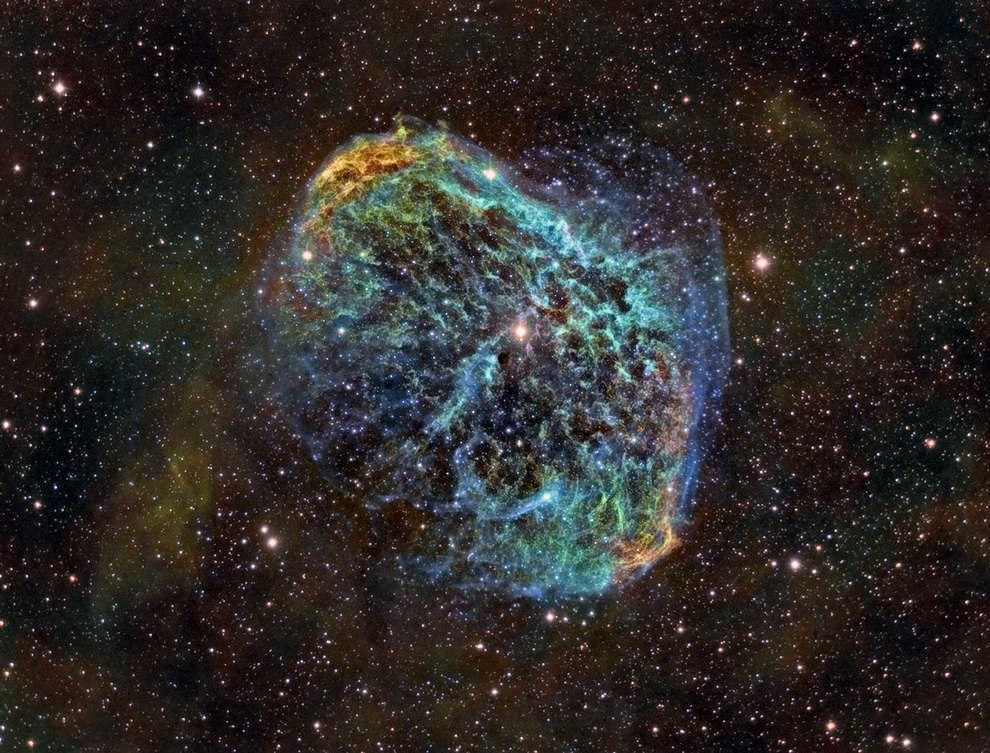
NGC 6888, commonly referred to as the Crescent Nebula, can be captured in stunning photographs.
Additional celestial objects worth observing through a telescope
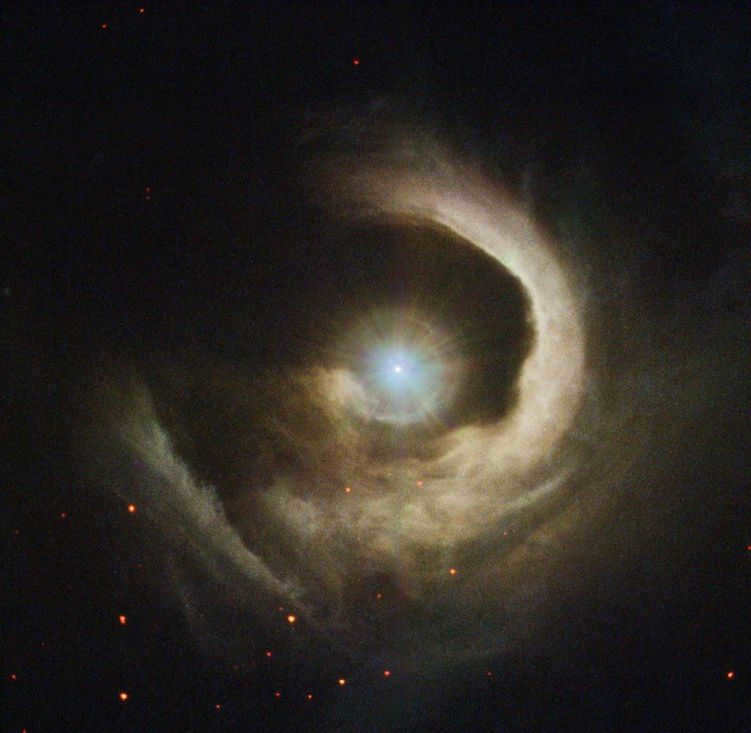

The photograph shows the Nebula surrounding the star V1331, which is located in the Swan constellation. This stunning image was captured by the Hubble telescope.
Another fascinating multiple star system, this time observable even without the aid of a telescope, can be found between the stars α and δ Cyg. These stars are known as Omicron 1 and Omicron 2, and both have a magnitude of 4.
If you have a pair of 7×35 field binoculars, you can observe that where the naked eye sees Omicron 1, there are actually two stars with magnitudes of 4 and 5. This system has also gained a third component, which becomes visible when the magnification is increased to 15-20x. Another star, with a magnitude of 7, can be seen near Omicron 1. Thus, this is a multiple star system consisting of four stars.
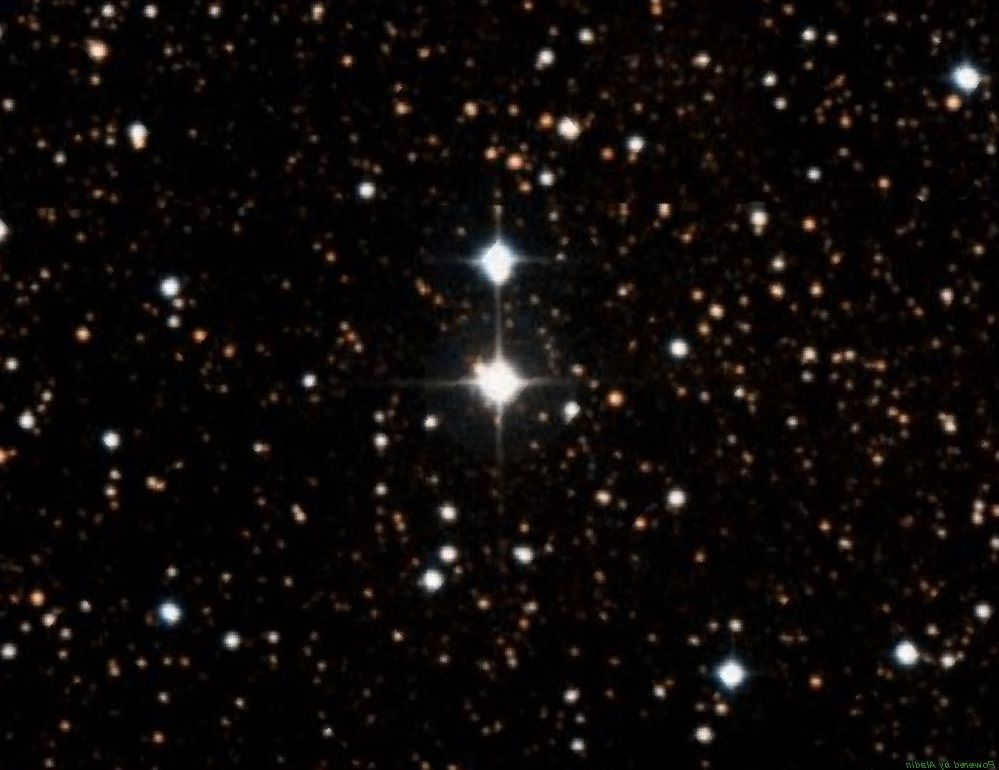

Photograph of Swan X-1 in the optical spectrum
In close proximity to ε Cyg, approximately one and a half degrees to the north-northwest, lies another remarkable celestial body – Swan X-1, which emits powerful X-rays. This star is also known to be a variable star, exhibiting fluctuations in luminosity from 5.9 to 6.9 magnitudes over a span of just 16.39 days.
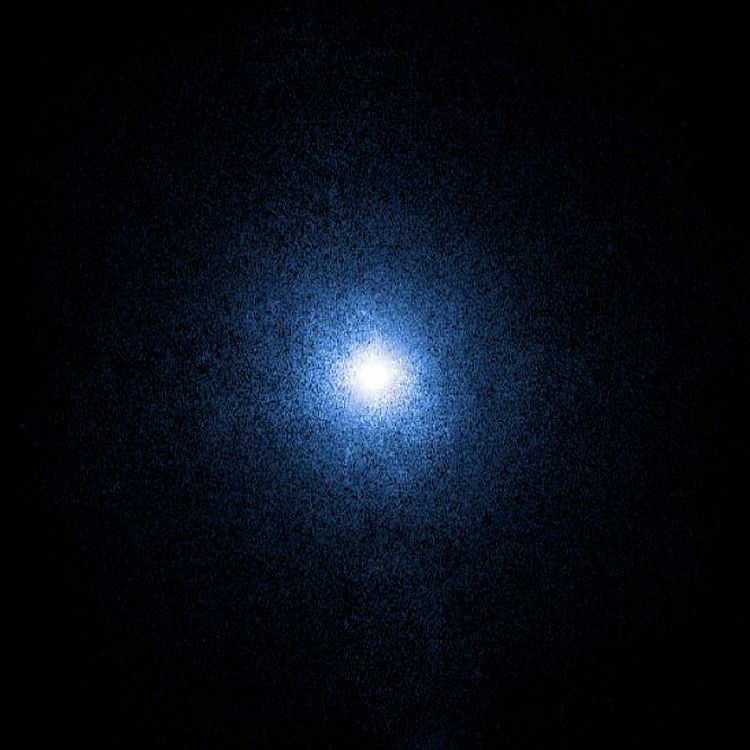
An X-ray image depicting the Swan X-1.
The Swan X-1 is an exceptionally bright source of X-rays and was the initial candidate for a black hole X-ray source.
Another star of great scientific importance within the Swan constellation is 61 Cyg, a binary star system and the first star whose distance was accurately measured through parallactic measurements, totaling 11.36 light years.
61 Cyg exhibits a notable proper motion over the course of a year.
This star is actually quite close to us and one of the few stars visible to the naked eye that displays significant proper motion. In the early 19th century, Giuseppe Piazzi referred to 61 Cyg as a “flying star”.
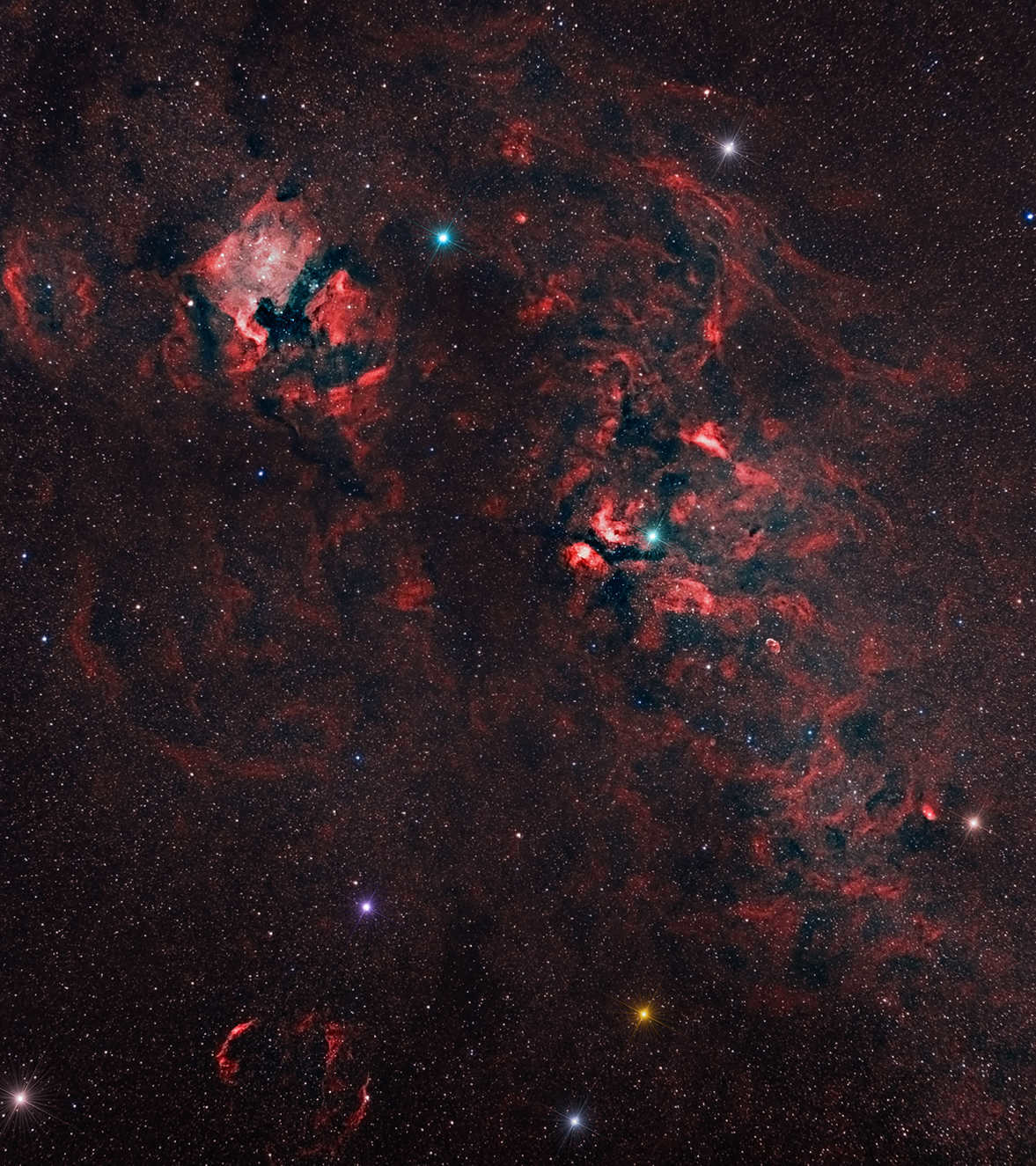
Picture The Milky Way area of the Swan constellation
Aside from containing numerous notable stars, the Swan constellation boasts an abnormally high abundance of celestial objects in the far reaches of space. There are over twenty-five scattered clusters, several emission clusters, and a significant quantity of dark nebulae. To catch a glimpse of these treasures, it is ideal to equip oneself with a pair of high-powered binoculars such as the 15×70.
A comprehensive look at the Swan constellation
The Coal Sack in the North
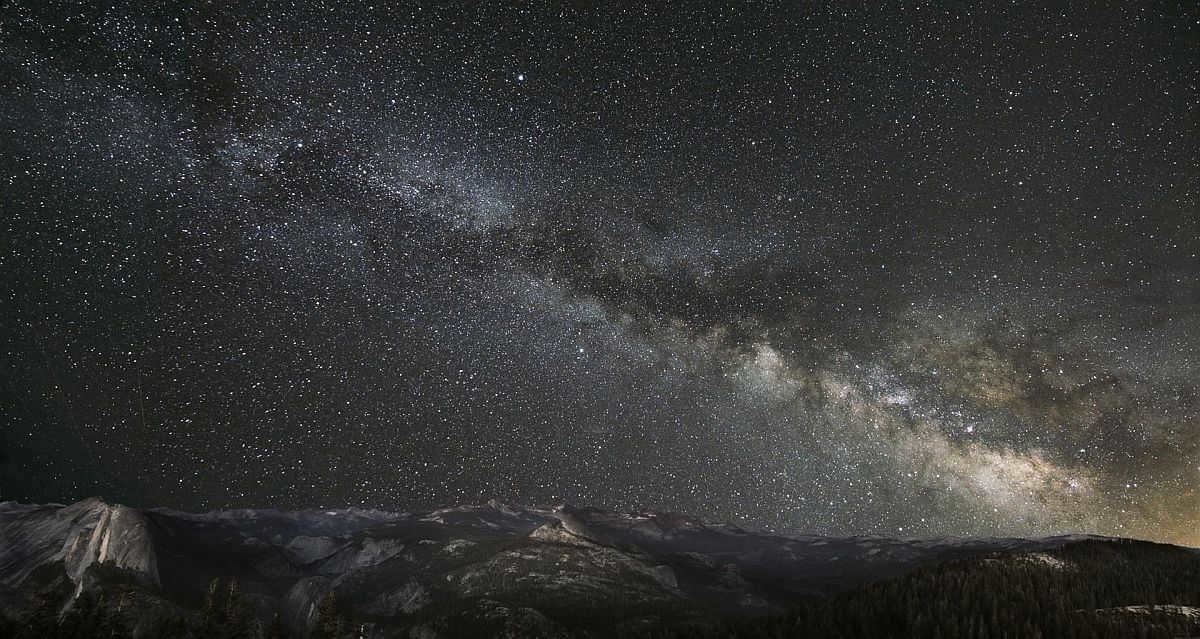
Below Deneb is where you can find a stunning image of the Northern Coal Sack.
First, let’s journey from the Southwest region of the constellation towards the Northeast. As we progress, each of these celestial objects will gradually come into our view. They will appear suspended against the backdrop of the Milky Way’s starry expanse, occasionally revealing darker “pockets”. These pockets are actually dark nebulae, which are clusters of cold and rarefied interstellar matter. One such nebula resides slightly south of Deneb and is known as the Northern Coal Sack (reminiscent of the Coal Sack in the Southern Cross constellation).
The best way to observe the Northern Coal Sack is by using wide-angle binoculars at low magnifications, up to 5x, or by simply looking with the naked eye on a clear and dark night sky. In either case, you will be able to see a unique dark formation that has an irregular elongated shape, with a dark band extending towards the South.
North America and Pelican Nebula
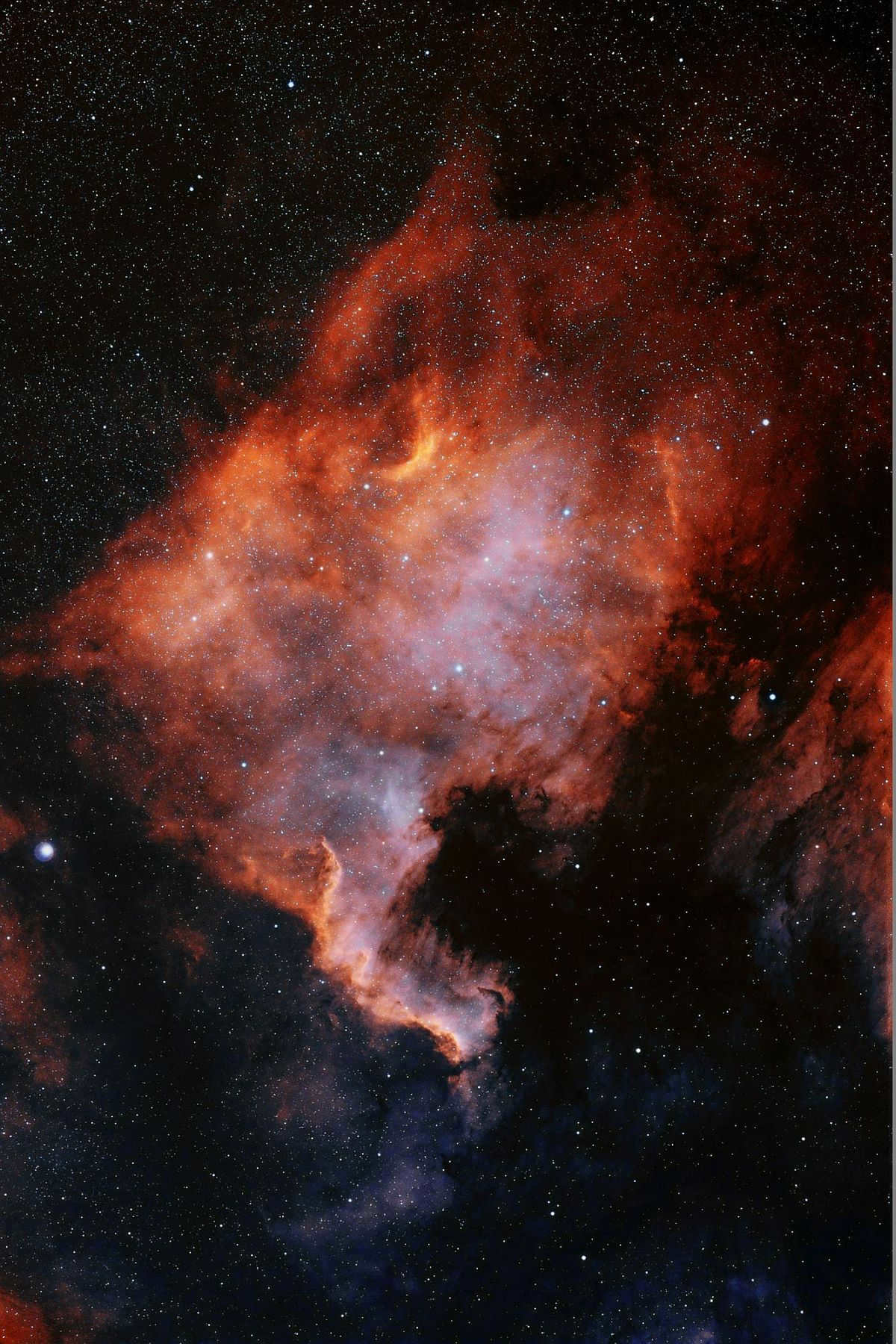
Image of NGC 7000 combined picture
Using Deneb as a reference point, we can locate the emission nebula NGC 7000, commonly referred to as the North America nebula. It is quite luminous.
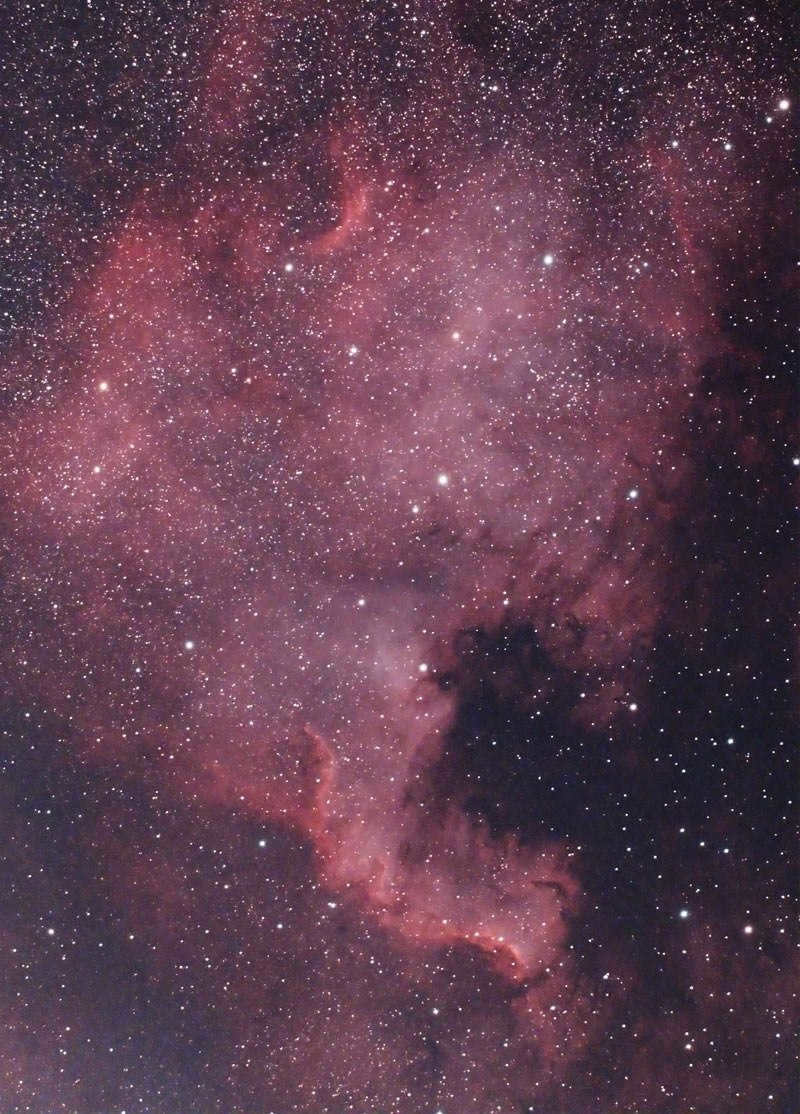
A picture showcasing the North America Nebula
The nebula possesses a stellar magnitude of 4.5, although its surface brightness remains relatively low. This is primarily due to its expansive emission area, which is so vast that it scarcely fits into a mere 2.5 degrees. Consequently, it is not uncommon for individuals to struggle in locating the North America Nebula initially. Furthermore, its contrast against the luminous star clusters of the Milky Way is rather minimal.
Observing NGC 7000: A Unique Experience
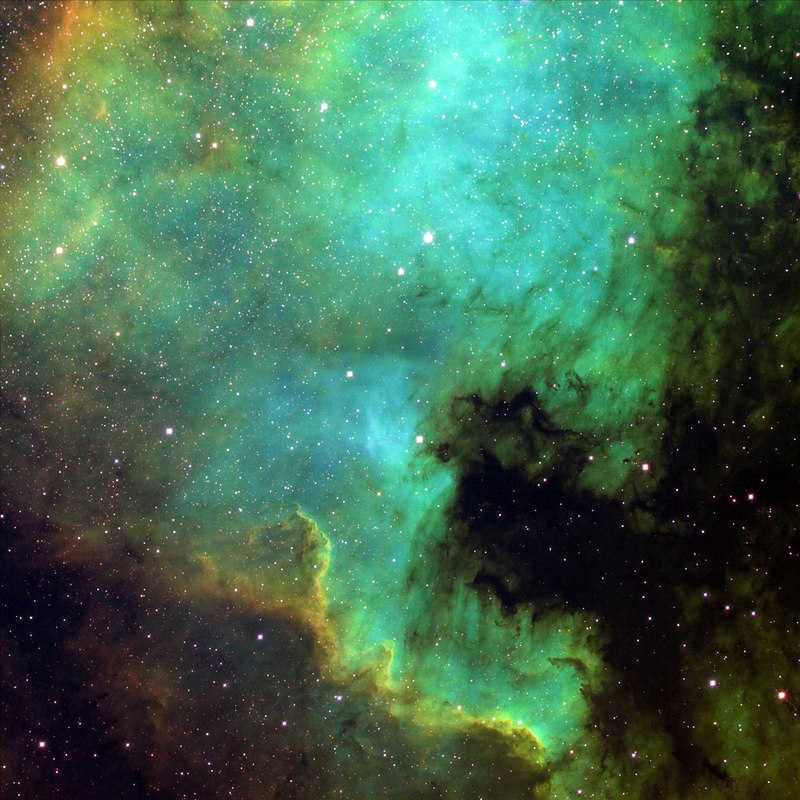
When you look up at the night sky in a rural or suburban area, you can easily spot a faint glow about three degrees east of Deneb. However, when you use binoculars to focus on the exact spot where the glow was visible to the naked eye, it becomes more difficult to see due to the brightness of the Milky Way. To locate NGC 7000 using binoculars, it is actually easier to orient yourself not towards the glow, but towards the dark area that resembles the “Gulf of Mexico” in the celestial “continent”. Once you have found this dark area, it will be much simpler to identify the distinct shape of the nebula.
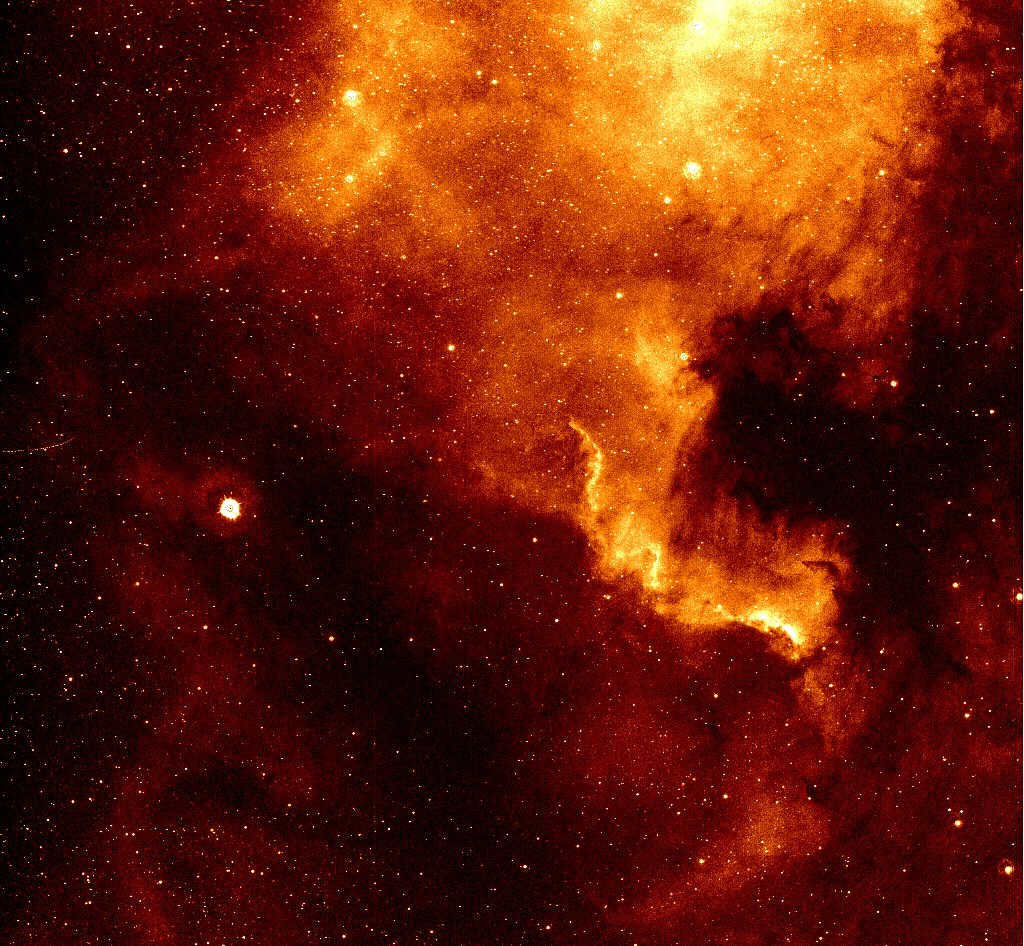
This hydrogen cloud, which serves as a birthplace for stars, presents a breathtaking sight when viewed through high-powered binoculars. The sheer size of the nebula is astonishing, barely fitting within the field of view at 15-20x magnification. Along the northeastern border of this celestial “continent,” individual strands can be observed, appearing as if they are delicately outlined by denser, softly glowing threads. The backdrop of the nebula, in addition to its evident luminosity, also showcases a multitude of stars, creating a mesmerizing gradient of light.
Additional information about the nebula
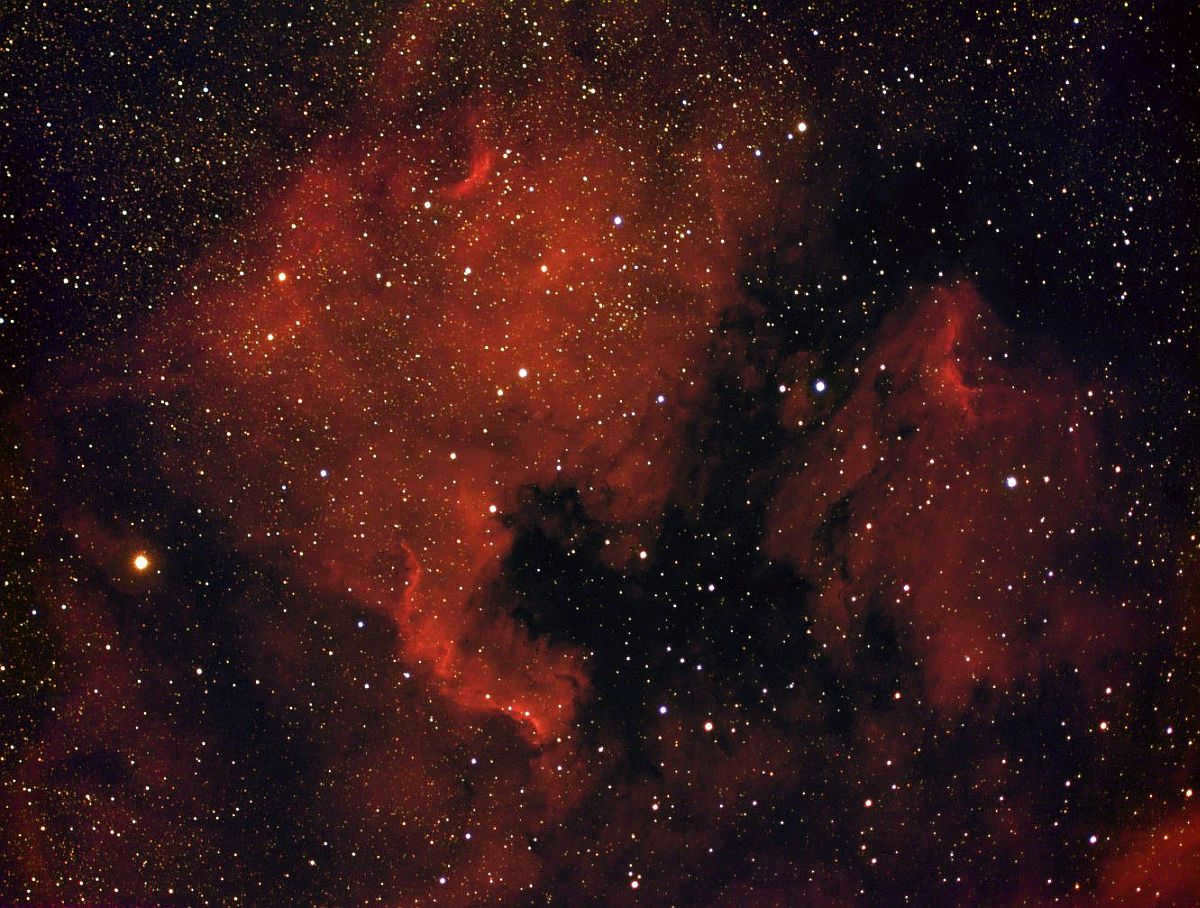
The image of NGC 7000 was captured using a filter that specifically isolates hydrogen wavelengths.
The southwestern region of the nebula, resembling the shape of Mexico, stands out more prominently, and it is quite noticeable to observe the dense glowing filament that stretches along its southeastern boundary. In contrast to the commonly held notion that increasing the telescope’s aperture and magnification enhances the level of detail, this is not the case for NGC 7000. On the contrary, the larger the aperture and magnification, the more challenging it becomes to distinguish the nebula amidst the vast background of the Milky Way’s stellar clouds.
The Pelican Nebula
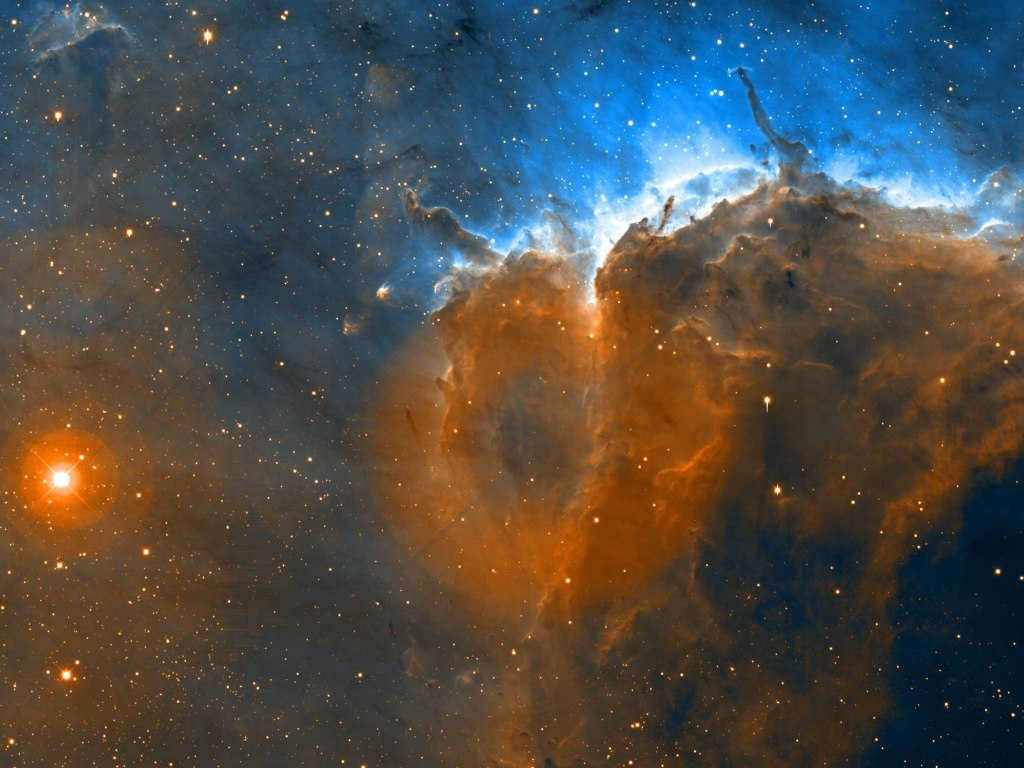
On the other side of the “Gulf of Mexico,” there exists a distinct nebular formation known as the Pelican Nebula. Despite their apparent separation in the night sky, both the North America nebula and the Pelican Nebula actually belong to one expansive region of doubly ionized hydrogen, with a dust band acting as a physical barrier.
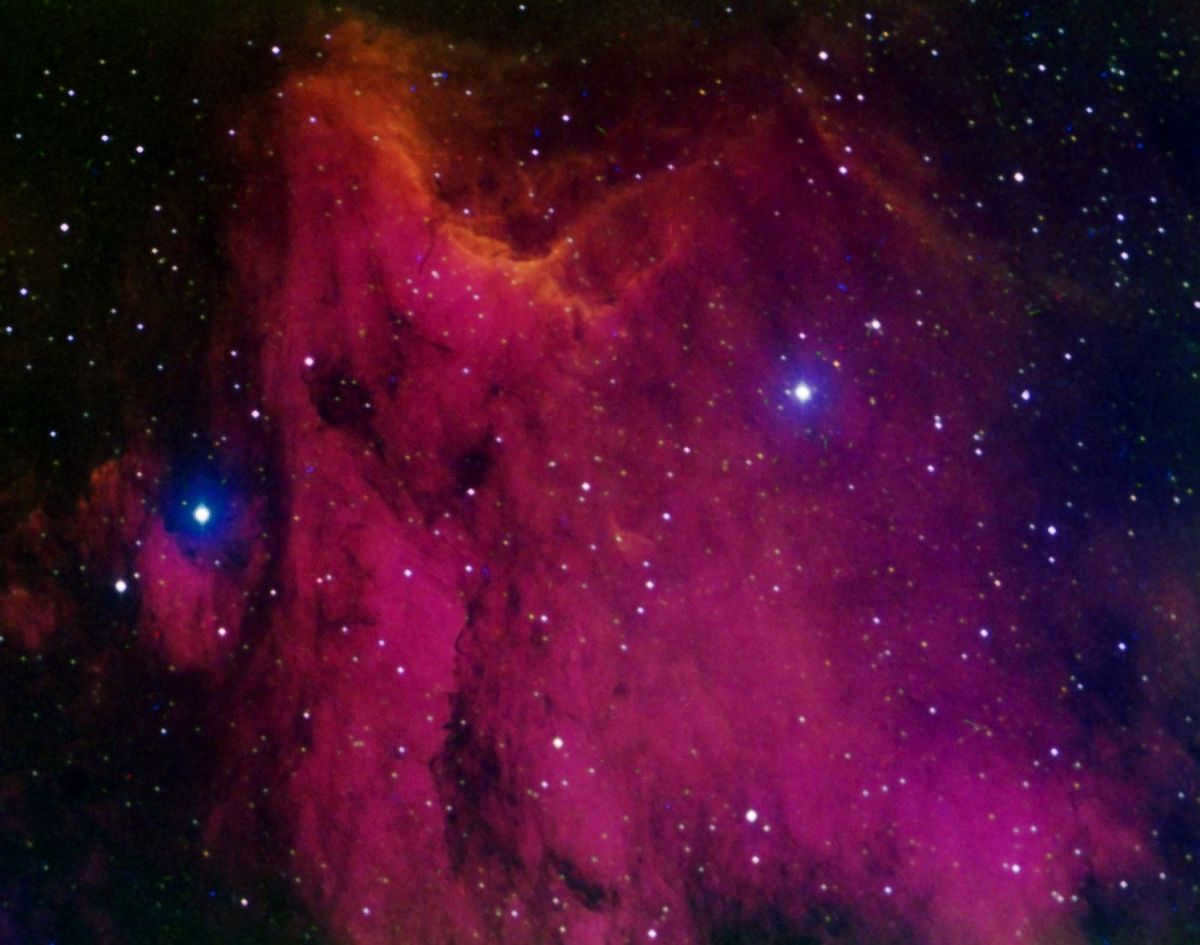
The Pelican Nebula, also known as IC 5070, is a photo emission nebula. It is a stunning celestial object that showcases beautiful colors and intricate patterns. This nebula is located in the constellation Cygnus and is a popular target for astrophotographers.
M39: A Scattered Cluster
M39 is a scattered cluster that is also located in the constellation Cygnus. It is made up of a group of stars that are loosely bound together by gravity. This cluster is relatively young, with an estimated age of around 250 million years. It is a fascinating object to observe and study.
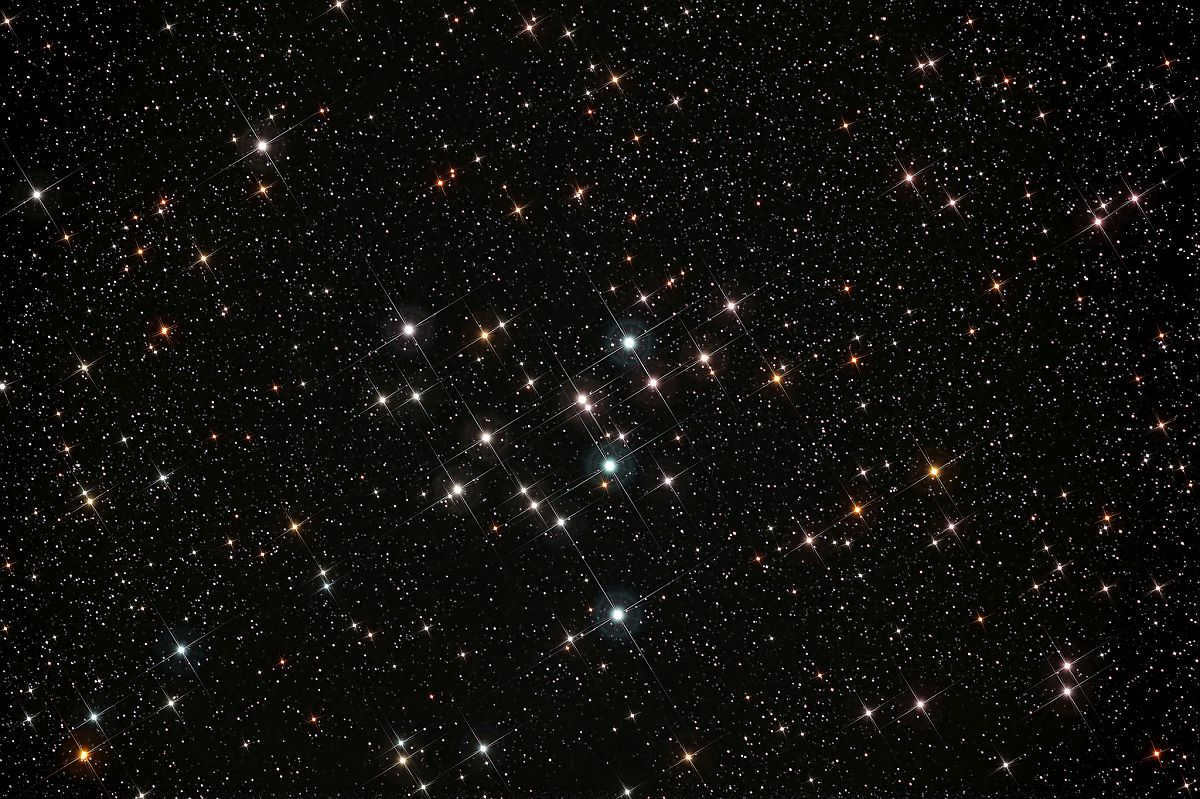
Image of the scattered cluster M39
From the star Deneb, we will move approximately 8 degrees towards the North-East to locate our next target – the M39 cluster. Even with a simple pair of binoculars, we can observe around twenty stars forming a distinctive heart-shaped cluster. With a larger telescope, you may notice a slight bluish hue in the starlight.
The M29 cluster
Cluster M29 is a group of stars located in the constellation Cygnus. This cluster is also known as NGC 6913 and is classified as an open cluster. It is located approximately 7,000 light-years away from Earth. The M29 cluster is relatively young, with an estimated age of around 10 million years. It is composed of about 80 stars, with the brightest one being a blue supergiant. The cluster is easily visible with binoculars or a small telescope. Its stars are loosely bound together by gravity and are gradually spreading apart over time.
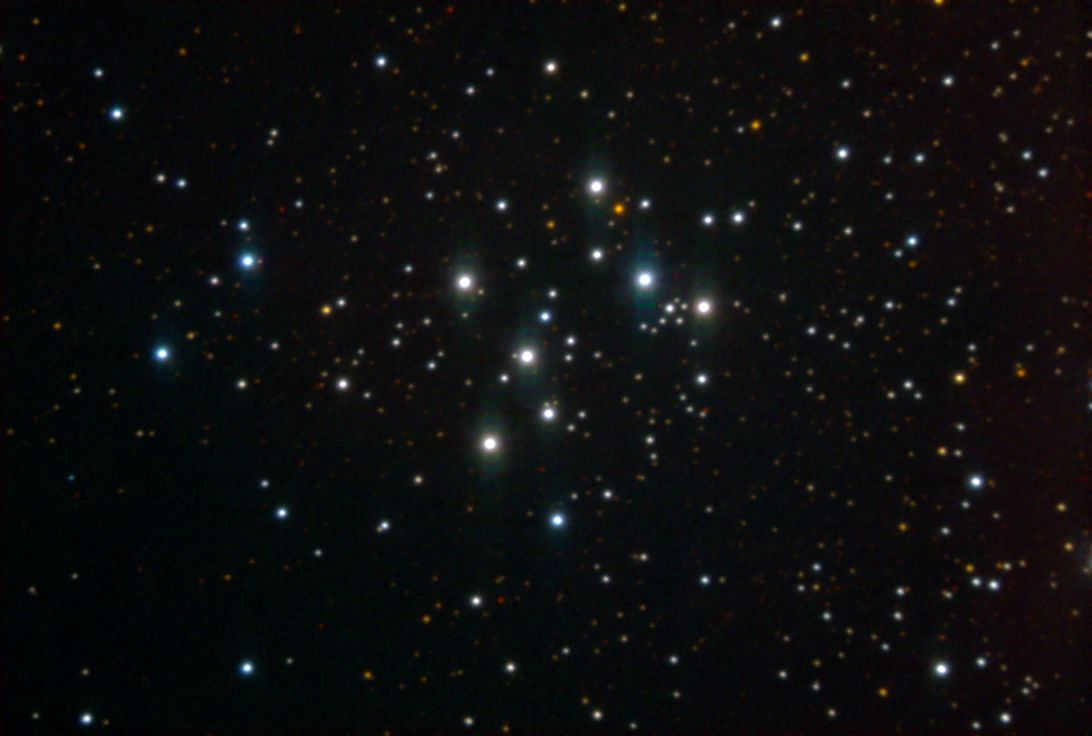
M29 is the final object in the constellation of Messier catalog, M29. It can be found approximately two degrees away from Sadr (γ Cyg). When observed through small binoculars, this group of stars appears as a compact and densely packed cluster, surrounded by a glowing halo. When viewed at a magnification of 20-30x, the cluster can be seen as a collection of around twelve bright stars arranged in an interesting geometric pattern, consisting of a rectangle and a triangle.
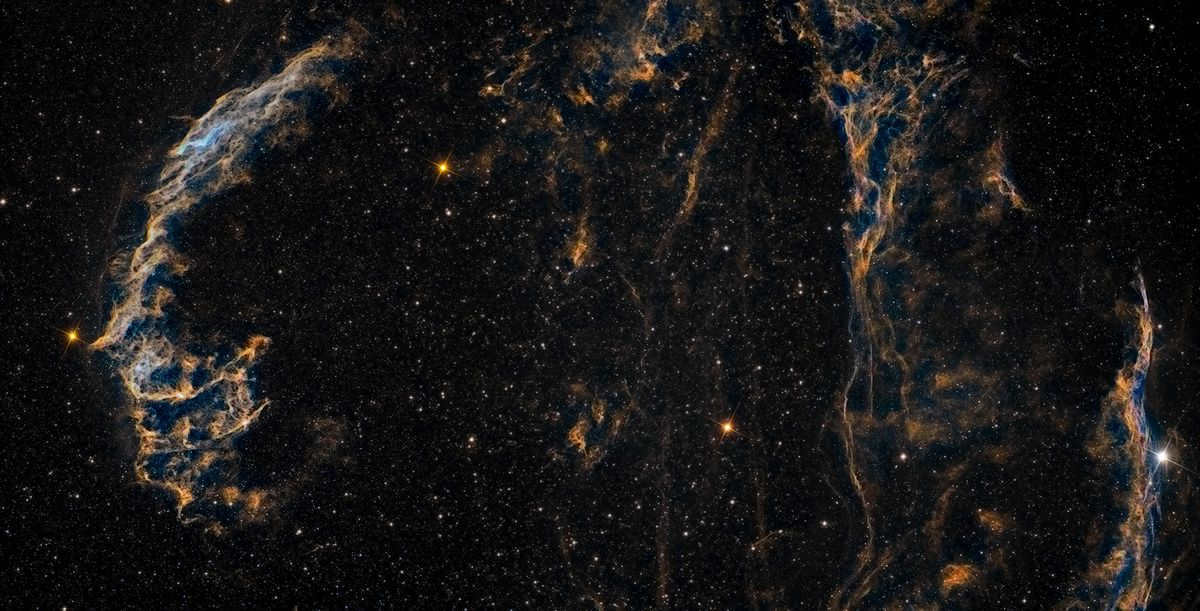
There is another fascinating entity located nearly at the midpoint of the direct path linking ε and ζ Cyg (specifically, 0.5 degrees towards the Southwest). This celestial phenomenon is the aftermath of a supernova explosion that occurred in the constellation thousands of years ago, estimated to be between 5,000 and 8,000 years. Scientifically designated as NGC 6992 or commonly referred to as the Veil Nebula, it offers us a remarkable opportunity to observe intricate features due to its relatively close distance of only 1400 light-years away. Even with telescopes of modest aperture, we can still discern a wealth of intricate elements within the Veil Nebula.
Observing the Nebula
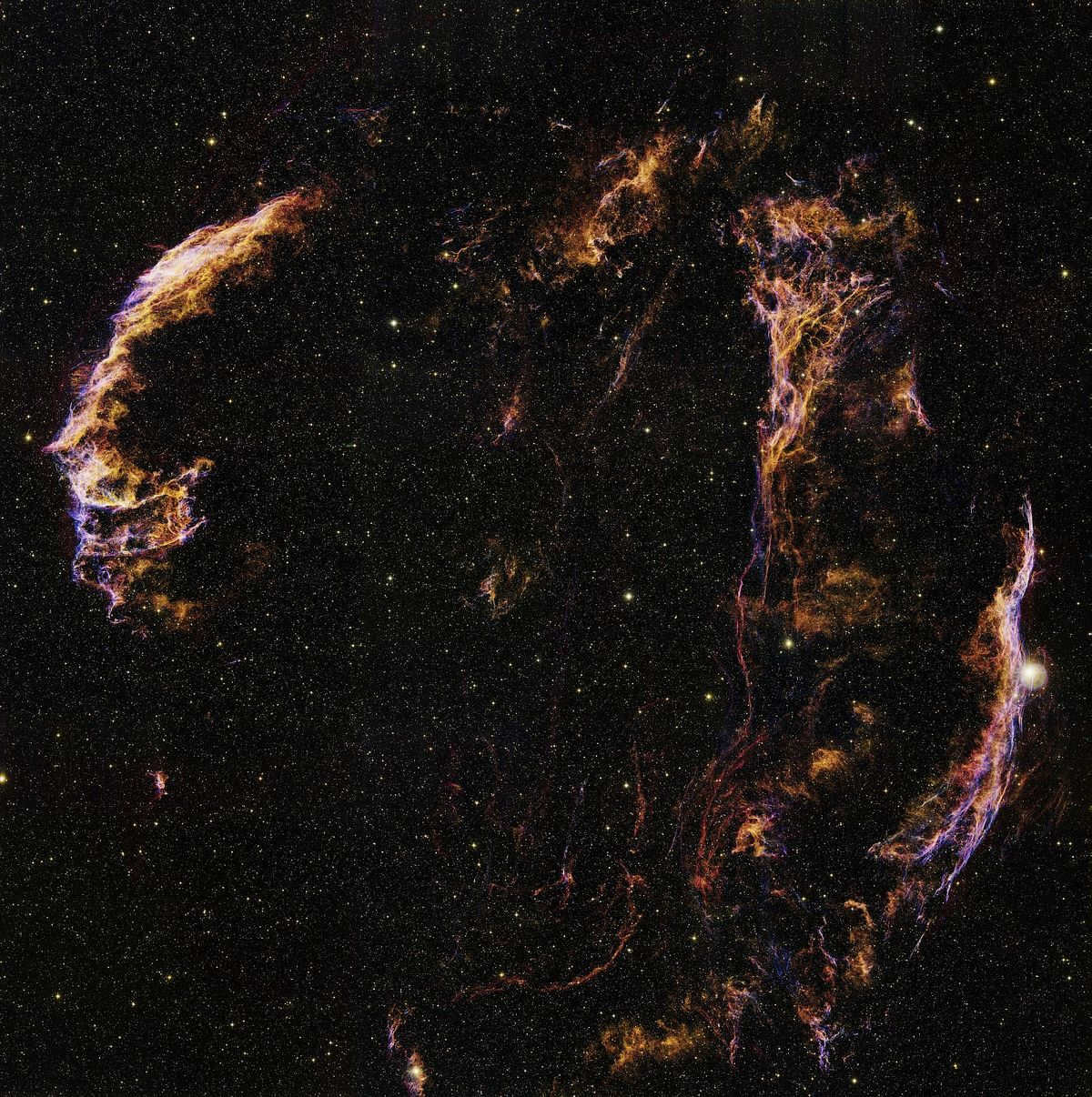
View of the Swan Loop Nebula
Therefore, when using binoculars in a clear and extremely dark sky, it is possible to easily observe the distinct northern and southwestern portions of the nebula, which appear as thin strands of nebulous material. This becomes even more apparent with larger apertures, and with 15×70 binoculars, the curved shape of the Northern Wing becomes clearly visible. There is also some variation in the brightness of the nebula, resulting in the Veil appearing fragmented into separate clusters rather than a continuous ribbon.
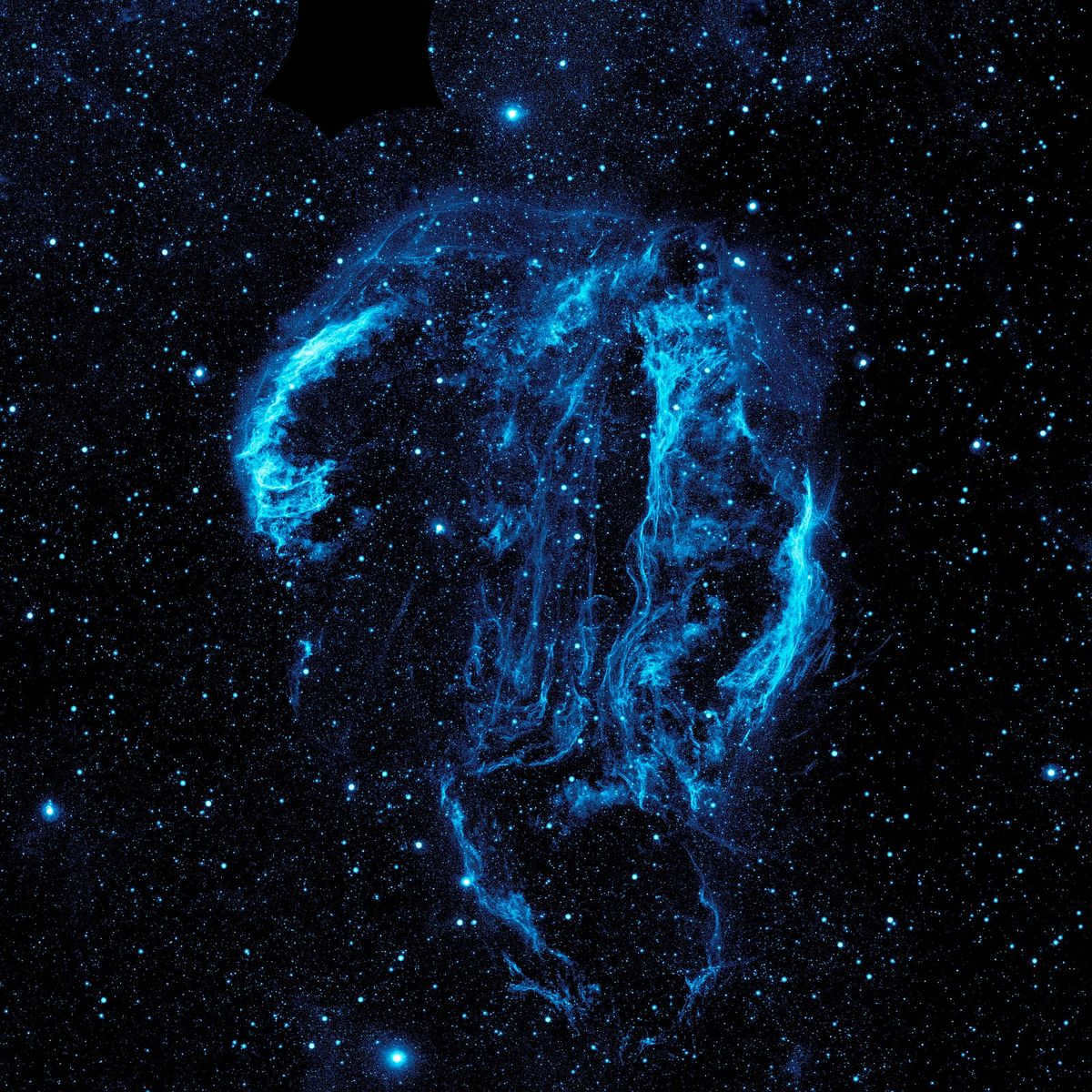
Swan Loop Nebula, UV image, is captured in this photo.
With a medium telescope that has an objective diameter of 90 – 120 mm, it is simple to observe all three components of the nebula. The nebulae can even be confidently viewed with a direct line of sight. However, with a larger aperture telescope ranging from 6″ to 8″, the intricate pattern of delicate dust fibers begins to emerge, revealing even more details.
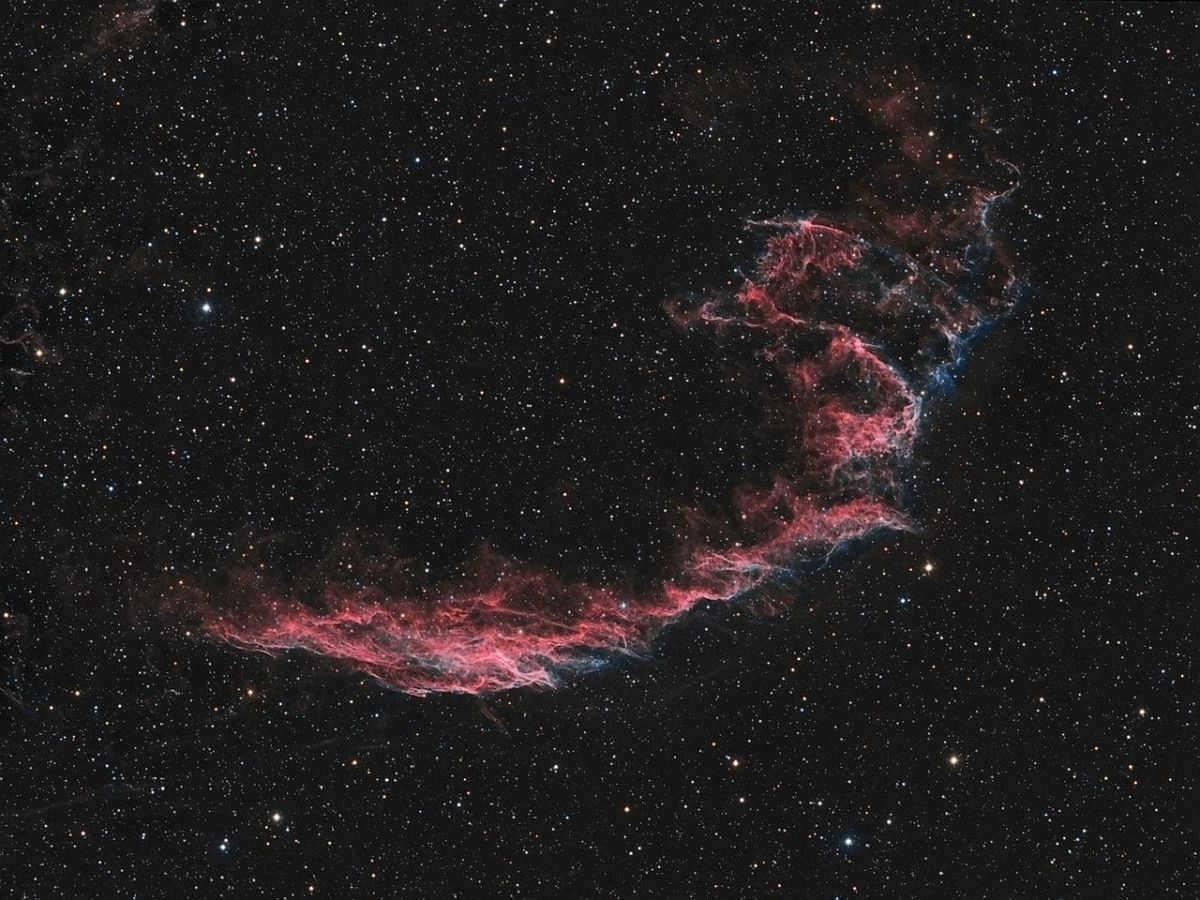
A picture of a section of the Veil Nebula
It is worth mentioning that when using more powerful instruments for observation, there may be some inconvenience as the entire nebula cannot be seen in the field of view, and one has to navigate through its expanse. The most captivating experience of observing the nebula can be achieved with a large astronomical binocular.
A journey to the Veil Nebula
The Nebula of the Witch’s Broom
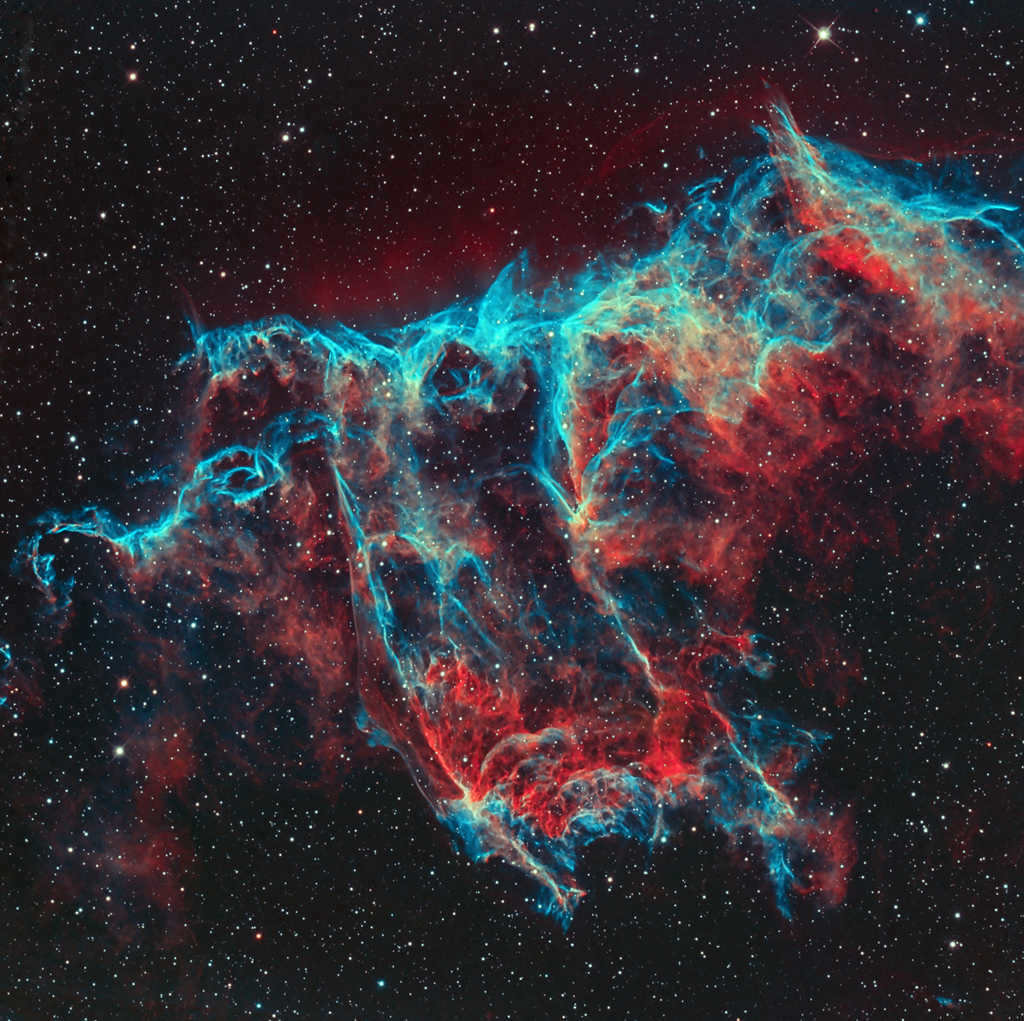
NGC 6960, also known as the Witch’s Broom, is another component of the supernova remnant. It can be easily located due to the presence of a bright blue-white star, 52 Cyg, positioned in its center. Despite its proximity and apparent connection, the Witch’s Broom is not directly associated with the nebula itself; rather, it is projected onto the supernova remnant.
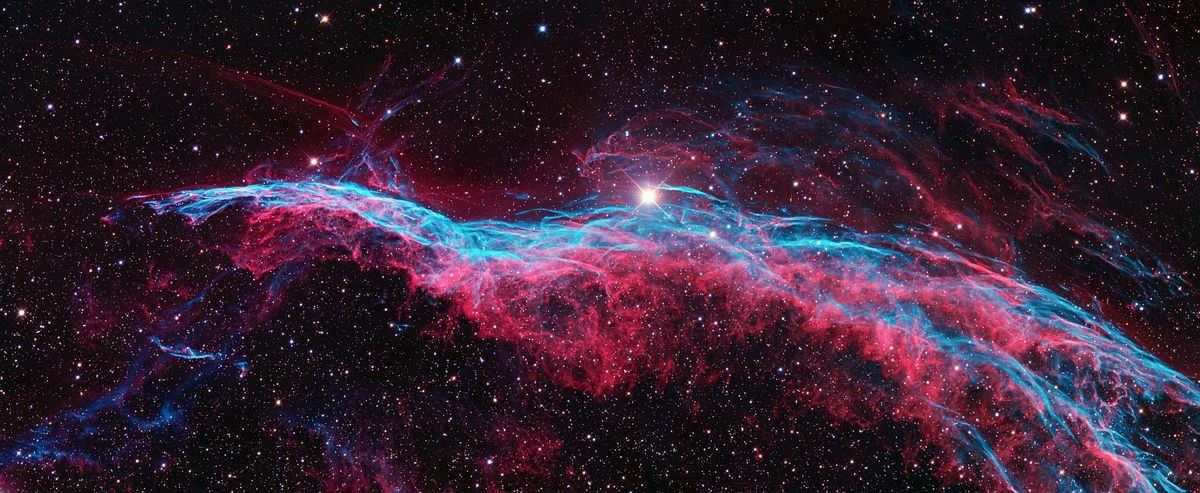
Fragment of the Witch’s Broom photograph
The Witch’s Broom exhibits a similar level of brightness as the Veil. When observed through a small telescope, it appears remarkably prominent amidst the expanse of the Milky Way, resembling a glistening stream of light that spans from the East to the West. To discern the delicate and intricate interweaving patterns, a telescope with a larger aperture of at least 6″ is required.
Dispersed groupings NGC 7082 and 7039
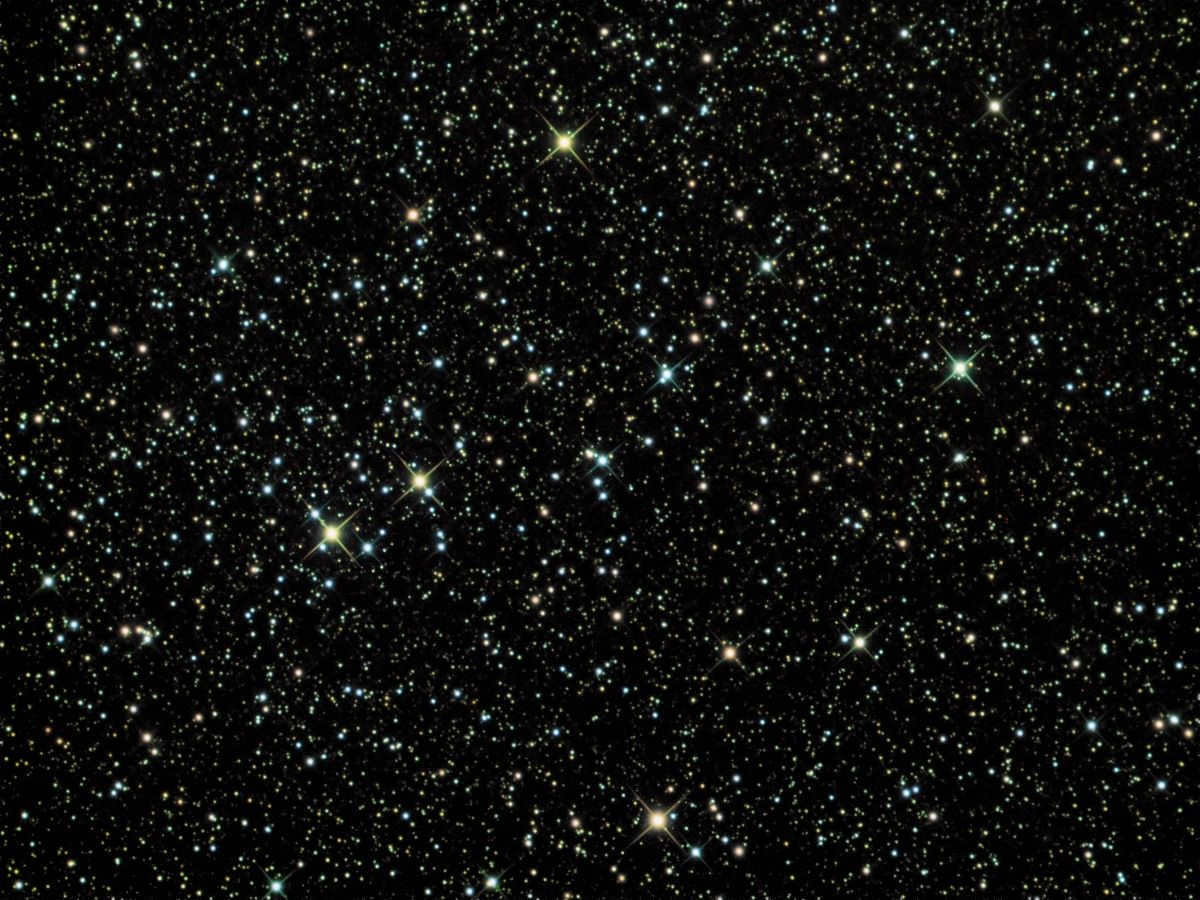
Starting from Deneb, let’s move towards the Northeast with a pair of binoculars. In that direction, you will come across a vast array of dispersed clusters. To the South-South-East of the previously observed M39, you can locate NGC 7082 and 7039.
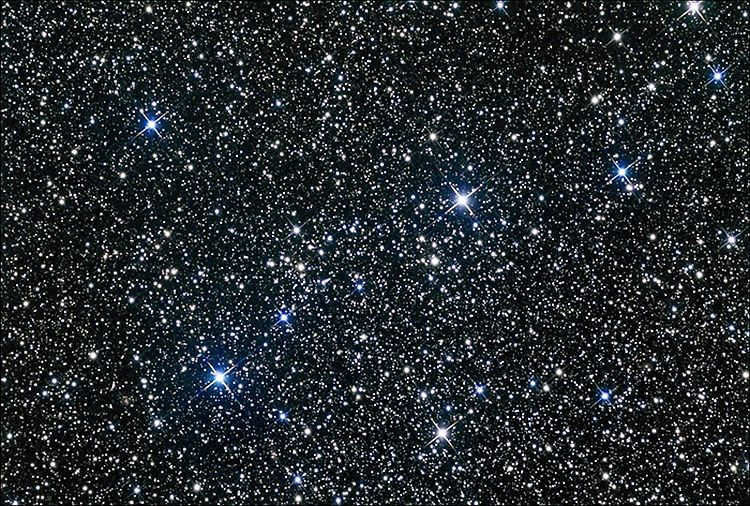
These star clusters are truly extraordinary, as you can easily spot each of them through binoculars, with around twenty-four distinct stars shining brightly against the glistening backdrop of the Milky Way.
The PK 64+5.1 Planetary Nebula
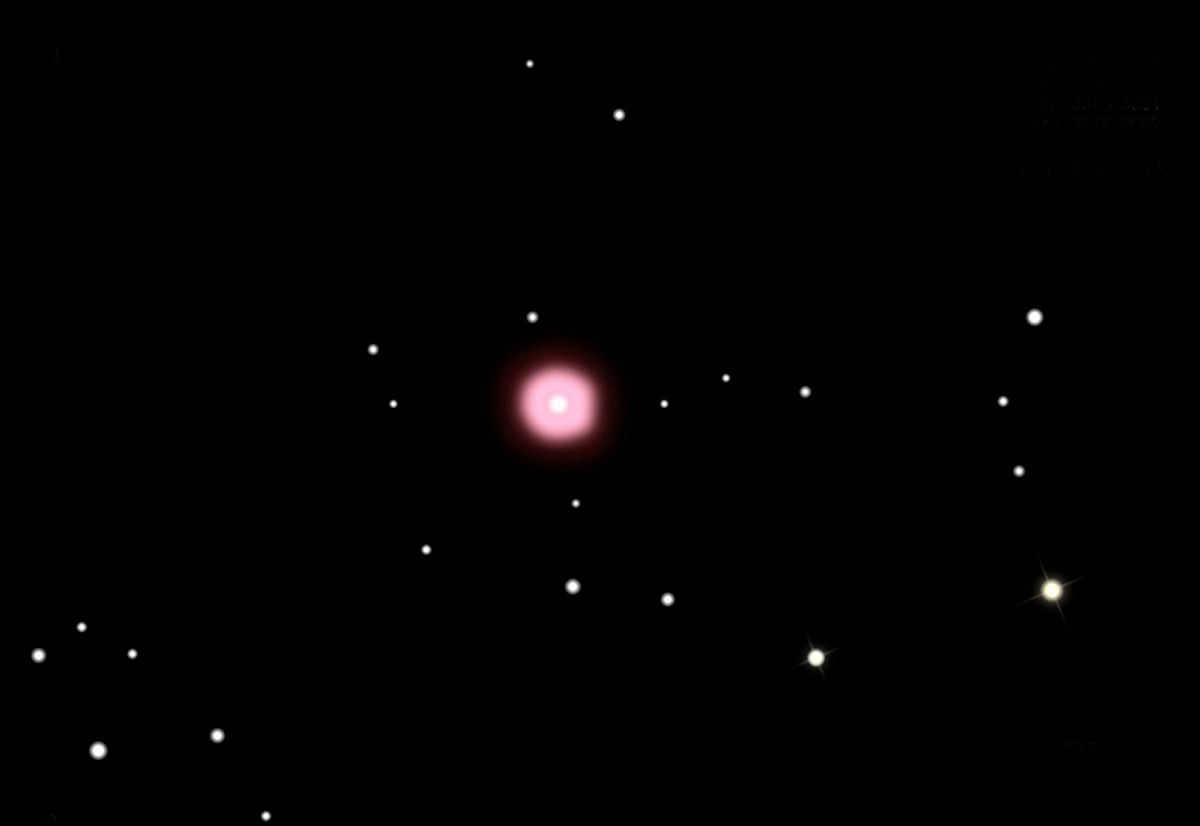
In the constellation Swan, there are at least two other planetary nebulae that have a stellar magnitude of ten. The brightest of them, PK 64+5.1, can be found almost three degrees NNW of Albireo (β Cyg). To locate the nebula, we need to go up from Albireo for about two degrees until we reach a star with a magnitude of 4.8. Next to it, about one degree to the NE, there is a brighter star with a magnitude of 3.9. The nebula is situated at the NW apex of an equilateral triangle.
Notable Characteristics of the Nebula
When observing this celestial body through nearly any telescope, it will typically appear as a diminutive, slightly indistinct star with a magnitude of 9.6. Due to this striking resemblance to a star, locating the nebula may pose some difficulties. To confirm that it is indeed a nebula and not simply a star, a magnification of approximately 80-100x would be necessary.
The Nebula’s Phenomenal Display
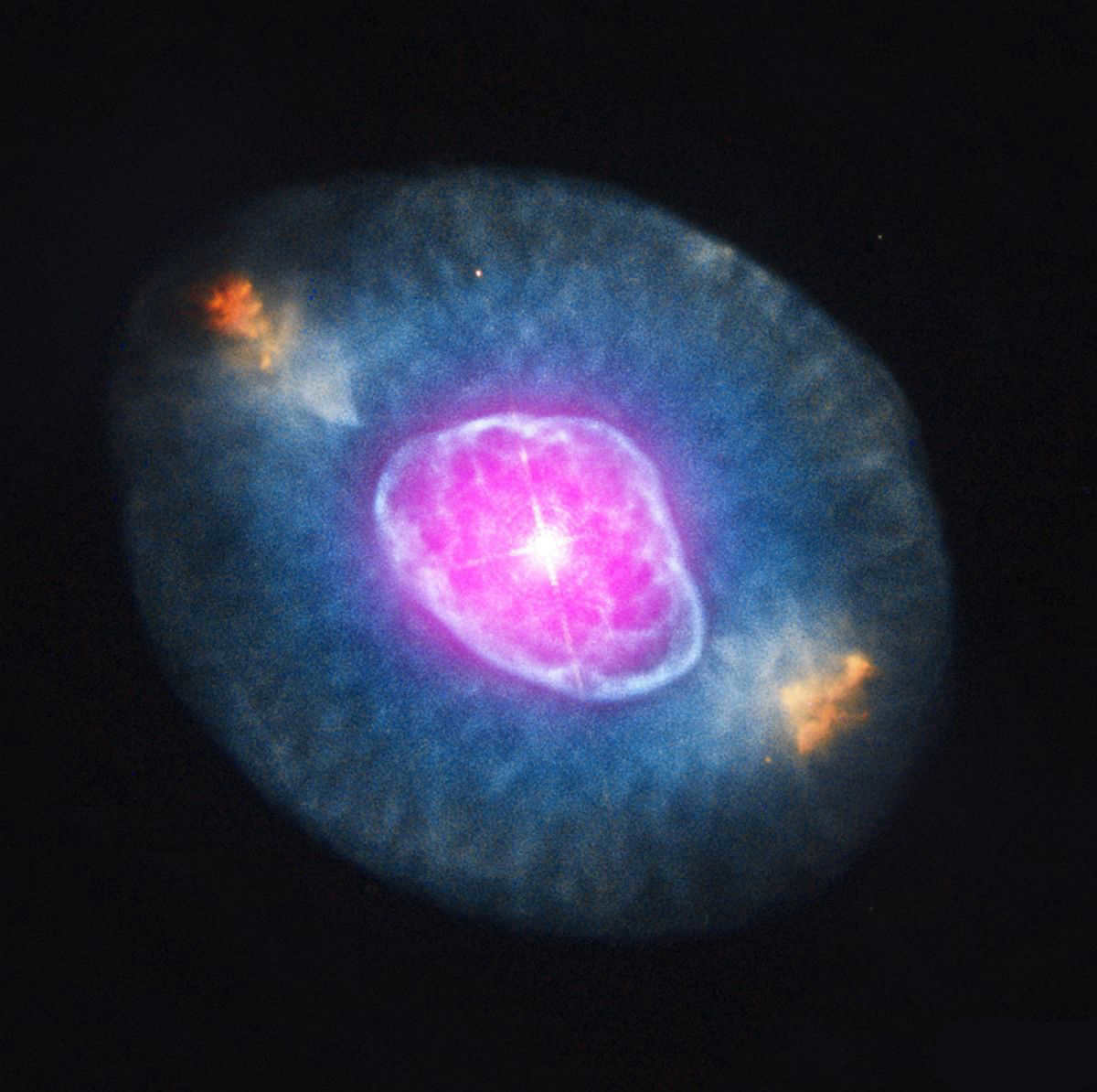
Composite image of NGC 6826, a planetary nebula
There is another planetary nebula, known as the Hubble Shimmering Nebula, which has a magnitude of 9.8 and is located near the star ι Swan. The Hubble Shimmering Nebula is famous and can be found in the New General Catalog under the designation 6826. Its exact location can be determined as follows: start at ι Cyg and move two degrees southeast to a visually multiple star system with a slightly lower brightness. One of the stars in this system is the variable star R Cyg. From there, travel 1.5 degrees East-Northeast to find NGC 6826.
An easy way to confirm the correct orientation is to look half a degree to the North from the expected position of the nebula. You should see a beautiful arc of stars forming a graceful chain.
Observations of NGC 6826
NGC 6826: A Fascinating Celestial Object
NGC 6826, also known as the Blinking Planetary Nebula, is an intriguing celestial object that has been observed by astronomers for many years. Its distinctive features and mysterious nature make it a subject of great interest and study.
NGC 6826 is located in the constellation Cygnus, approximately 2,200 light-years away from Earth. It is classified as a planetary nebula, which is the glowing shell of gas and dust ejected by a dying star in its final stages of evolution.
One of the most striking features of NGC 6826 is its bipolar shape, which resembles a pair of wings or an hourglass. This unique morphology is believed to be the result of the star’s strong stellar winds interacting with the surrounding interstellar medium.
Observations of NGC 6826 have provided valuable insights into the physical processes occurring within planetary nebulae. Astronomers have used various instruments, such as spectrographs and imaging cameras, to study the nebula’s chemical composition, temperature distribution, and density variations.
These observations have revealed the presence of several chemical elements in NGC 6826, including hydrogen, helium, oxygen, nitrogen, and carbon. The relative abundances of these elements can provide clues about the star’s evolution and the nucleosynthesis processes that occurred during its lifetime.
In addition to its scientific significance, NGC 6826 is also a popular target for amateur astronomers. Its brightness and distinct shape make it relatively easy to observe with small telescopes. Many amateur astronomers have captured stunning images of this celestial object, showcasing its beauty and intricate details.
Overall, NGC 6826 continues to captivate astronomers and enthusiasts alike with its enigmatic nature and mesmerizing appearance. Ongoing observations and studies of this fascinating planetary nebula will undoubtedly contribute to our understanding of stellar evolution and the formation of complex structures in the universe.
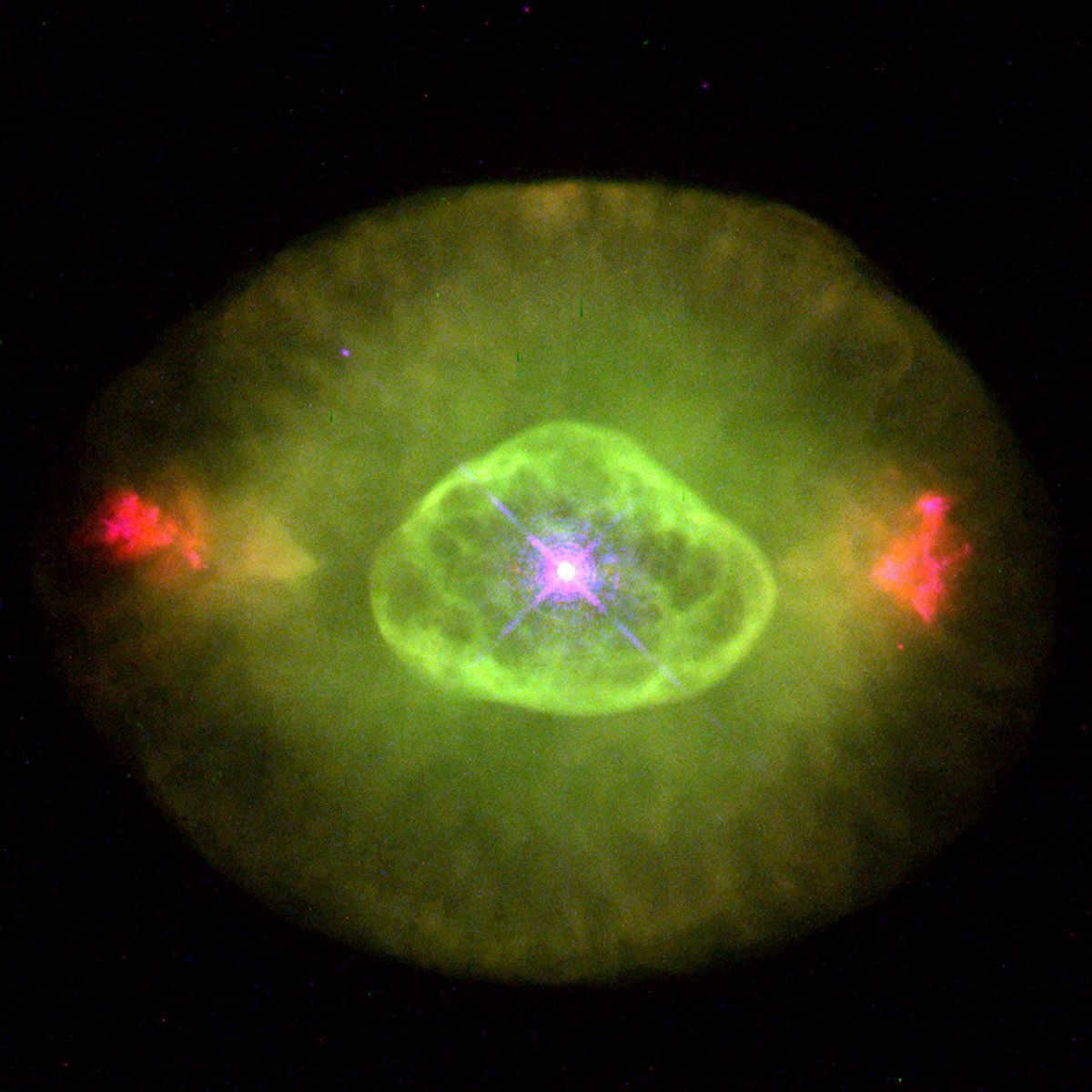
Photo of the Shimmering Nebula or NGC 6826
The nebula known as “Flickering” got its name for a reason – when observed through a telescope of medium aperture, it appears to change its brightness when transitioning from side to direct vision. This phenomenon is caused by the presence of a double shell in the planetary nebula. The outer, less bright shell is only visible when viewed from the side, while the inner shell can be seen even when viewed directly.
This distinctive feature can be observed in telescopes with an aperture of 100 mm and larger. However, in smaller instruments, spotting this phenomenon is not straightforward: despite its luminosity, the nebula is relatively small in size and can be easily mistaken for a star. Nevertheless, perseverance and hard work will be duly compensated: the heavens will eventually unveil and provide the chance to witness this marvel of the cosmos.
The Constellation’s History
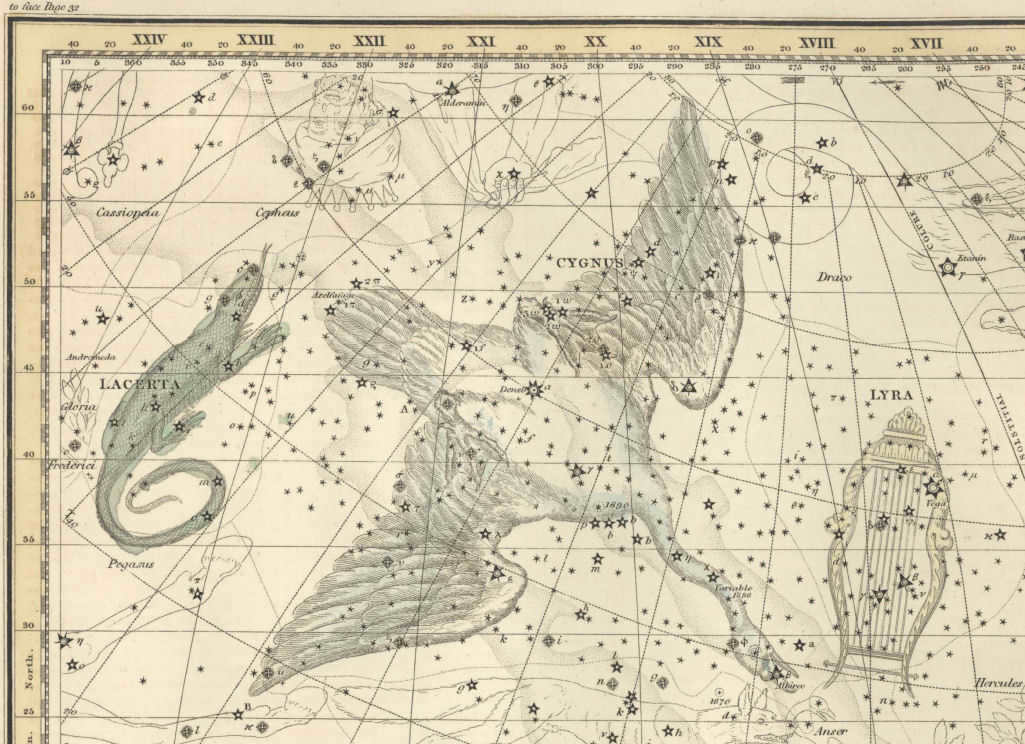
A depiction of the Swan taken from an ancient star chart
The Swan is a constellation with roots in ancient Greek mythology, originally known as the Bird. There are various explanations for the inclusion of the Swan in the night sky, one of which stems from a Greek legend. It is said that the Swan represents Jupiter (Zeus) taking on the form of a bird in order to pursue a romantic relationship with Leda, who was married to Tyndereus. Another possible origin for the constellation is tied to Cycnus, the son of Poseidon. After being abandoned by his parents, Cycnus was raised by a swan and eventually became deified in the form of a bird. The inclusion of this constellation in Ptolemy’s Almagest during the 2nd century further solidified its significance.
When you gaze up at the clear summer night sky, you may feel a sense of dizziness due to the sheer abundance of stars. The vast expanse of space that stretches above us has always captivated our curiosity, with its enigmatic allure. To make things easier, the multitude of stars is categorized into constellations. The optimal time to observe each constellation depends on its specific location. If we were to venture from Earth into the depths of space, we would find that the celestial patterns we are familiar with from our childhood no longer exist. The individual objects that form the constellations appear to scatter and lose their cohesive unity. This is because each constellation is a projection of a specific section of the sky, where all the celestial bodies within that section are plotted from the perspective of an observer. In reality, the distances between these cosmic bodies can span thousands of light years.
One of the most well-known depictions of the night sky is the constellation known as Cygnus, or the Swan. This collection of stars forms the shape of a graceful bird in flight, with around 150 stars that are some of the brightest objects visible from Earth. These prominent stars make it relatively easy to locate the Cygnus constellation in the night sky.
Stargazing
From an early age, many amateur astronomers are familiar with the distinct shape of the Cygnus constellation. The stars that compose it are arranged in a cross formation, resembling a majestic bird with an elongated neck and expansive wingspan. The silhouette leaves no doubt as to why this collection of stars is associated with the image of a swan.
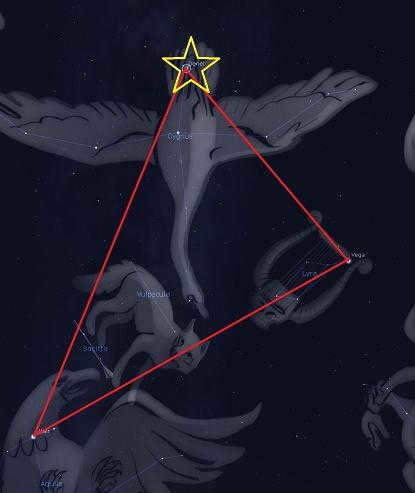
Background
The current sky map we are familiar with has not always been in its present form. This is due in part to the fact that stars undergo changes in their positions over time. This phenomenon is particularly evident in the case of celestial bodies that are closest to us. For instance, more than 17,000 years ago, the star known as Polaris was not in its current position but was instead referred to as Deneb.
Another factor contributing to the differences between celestial maps of the past and present is the way stars are grouped together. The earliest known descriptions of constellations can be traced back to 275 B.C. These descriptions were initially formulated by the Greek poet Aratus. Several centuries later, Ptolemy revised Aratus’ work in his famous book called the Almagest, which includes a list of 48 constellations. Over time, one of these constellations (Argo) was divided into three separate constellations (Carina, Vela, and Puppis), while the others have retained their original names up to the present day.
Currently, there are 88 constellations that are recognized by scientists. Among these constellations, one of the oldest is the Swan, which was originally referred to as the Bird in Ptolemy’s list. The history of the Swan constellation can be traced back to the ancient times, with references to it found in the works of astronomer Eudoxus of Cnidus, dating back to the fourth century BC. The names given to the stars within the Swan constellation reflect the time when many scientific fields, including astronomy, thrived in the Eastern regions, particularly in Arab countries.
Star Bridge
Deneb, also known as Alpha of the Swan, is the most brilliant star in the constellation Swan. Its name, which translates from Arabic as “tail,” accurately reflects its position. Deneb adorns the constellation Swan (see diagram below) precisely at the point where the bird’s tail is located. This celestial object is classified as a white supergiant. The magnificence of Deneb becomes apparent when comparing it to our own sun. Deneb has a mass twenty times greater than that of the sun. Estimates of the distance from Earth to Deneb range from 1.55 to 2.6 thousand light years. Despite this vast distance, Deneb is clearly visible in the sky due to its luminosity, which is 270 thousand times greater than that of the sun.
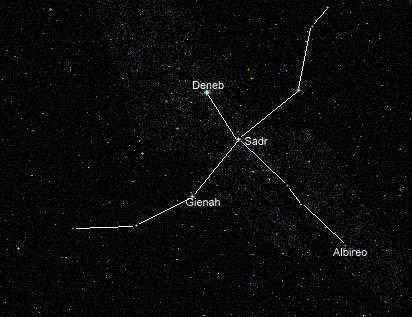
As previously stated, the Summer Triangle includes Deneb. Deneb is linked with a captivating Chinese myth where it serves as a connection between the celestial lovers Vega and Altair. This mythical event occurs once a year, allowing the lovers to spend a night together before parting ways again for another year.
Albireo (beta Swan) is situated at the opposite point of the constellation Swan from Deneb. It adorns the head of the bird. To get a glimpse of the appearance and location of the Swan constellation, one can simply locate these two luminous points. Albireo, like Deneb, is visible to the naked eye. Those who opt to observe it through a telescope will be treated to an even more fascinating sight. Albireo is a binary star system. The larger star, Albireo A, is an orange giant. Its companion is a blue star in the Main Sequence, known as Albireo B. The star’s name is derived from the Arabic phrase “beak of the chicken”.
Gamma and Delta of the Swan
The focal point of the constellation is Sadr, which is synonymous with “chest”. It is the second most brilliant star. Sadr (Gamma of the Swan) is a supergiant star categorized as an F8 spectral class, with a pulsation period of 74 days. It possesses a mass 12 times that of the Sun.
Following Sadr in terms of brightness is Delta Swan. It is a binary star system situated at a distance of 170 light-years from Earth. It is more challenging to discern compared to Albireo. Delta comprises two stars that are in close proximity, completing an orbit every 537 years. The first star is a blue-white giant with significantly greater luminosity than the Sun. Its companion is a yellow-white star, which is less remarkable in terms of all parameters.
Benchmark
Epsilon Swan, also known as Jenach, is not only a notable point on the celestial map but also a crucial factor in astronomical calculations. Situated approximately 73 light years away from Earth, this celestial body holds significant importance. The translation of its name, Jenach or Gienach, means “wing,” which aptly describes its position in the constellation. It emits a luminosity 62 times greater than that of the Sun.
What sets Jenach apart in scientific studies is its spectrum, which serves as the standard for classifying other stars. Moreover, it was on this celestial entity that the discovery of Neptune took place in 1846.
Northern Cross
The children and adults are familiar with the constellation Swan, which is also known by another group of stars called the Northern Cross. This formation consists of the five stars mentioned. The bottom of the Cross is represented by Albireo, while the top is indicated by Deneb. In the middle of the asterism lies Sadr, with Jenach and Delta Swan on the sides. These stars are the most prominent features of the Swan constellation. Despite lacking the vibrant glow of other elements, the constellation (as shown in the photo) is still captivating. It’s worth noting that the five stars are not the only interesting objects within the celestial bird. However, it is the Northern Cross that truly stands out and catches the attention. Finding this asterism is often effortless, as it is widely recognized by almost everyone.
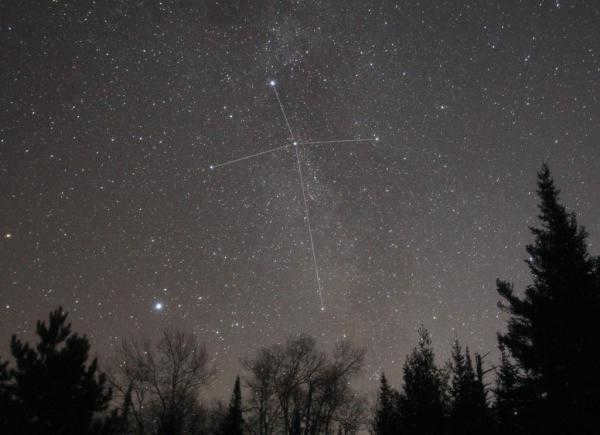
Another “population”
There is another fascinating entity in the constellation known as 61 Cygni, which is a binary star system composed of two orange dwarfs. Similar to Albireo, this system can be observed from Earth and is an excellent subject for scientific investigation. What makes 61 Cygni particularly intriguing is its proximity to the Sun, as it is one of the closest stars, located 11.36 light-years away. Moreover, this star exhibits a notable proper motion and belongs to a select group of similar celestial objects visible from our planet. 61 Cygni gained renown in the field of astronomy during the mid-20th century due to the belief that it harbored a planetary system. However, subsequent data have failed to support this hypothesis, yet the star remains the focus of extensive research and scrutiny among the scientific community.
There is another fascinating object to explore in the constellation, which is the Swan X-1 black hole located near 61 Swan. This black hole stands out as the most luminous source of X-rays in the entire constellation. Swan X-1 has been identified as consisting of two entities: a brilliant blue star and its companion, which unfortunately cannot be observed directly. The emission of radiation is a consequence of the matter from the blue star flowing into the black hole. During this journey, the matter becomes immensely hot and some of it is expelled into space in the form of two jets that project in opposite directions from the object. It was during the 1970s that Swan X-1 was officially classified as a black hole.
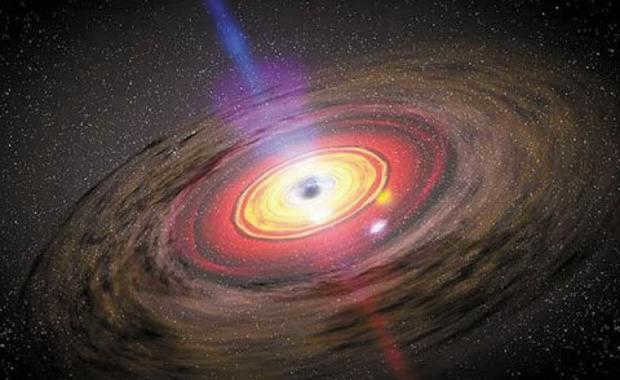
Astrospheres
Stars are not the sole entities encompassed in the constellation Swan. Its configuration also incorporates a dim area known as the Northern Carbon Pocket. This is an interstellar accumulation of particles and gases in close proximity to our Galaxy. A variety of astrospheres are also present. The assembly of celestial bodies, denoted as the Veil or Web (NGC 6960 and NGC 6992), are the remnants of a supernova eruption 40,000 years ago. Positioned at the western boundary of the Veil is the Witch’s Broom Nebula, remarkably exquisite in telescope imagery.
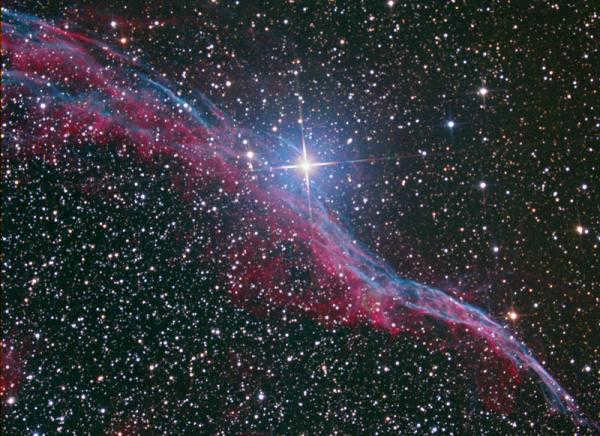
The tale of Orpheus and the lyre
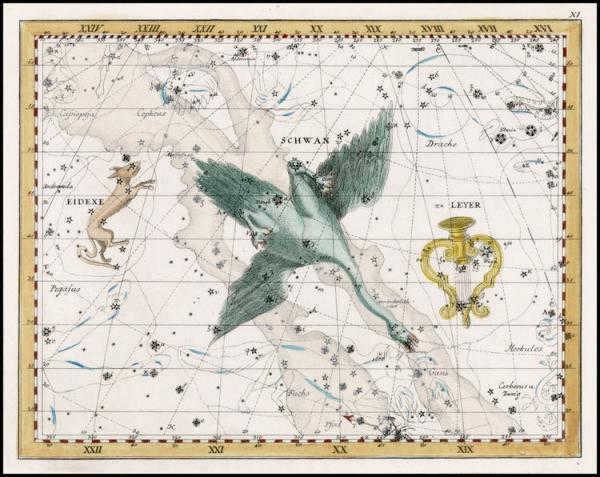
Phaeton
There are a number of other myths that explain the reason why we now have the constellation Swan. The story is about Phaethon, the son of the Sun god Helios. As a mortal, Phaethon wanted to prove his divine origins and begged his father to allow him to ride the solar chariot across the sky. Helios agreed to his request. However, Phaethon, filled with pride, was unable to control the fiery horses and ended up falling out of the chariot and into a river. On Earth, his loyal friend Kiknus searched for his remains for a long time. Seeing the sorrow of Kiknus, the gods decided to transform him into a swan. In this new form, he lived by the water. Zeus, wanting to immortalize their selfless friendship, placed the constellation Swan in the sky. There are other variations of this legend, which focus on a hero named Kikn. In Greek, his name means “swan”.
Variations in the Origins and Demise of Kikn
In various myths, the hero who later became a noble bird was believed to be the son of different gods. One version states that he was born to Apollo and met his death by drowning in a lake, now known as Cycnaeus. Another tale features him as the offspring of Poseidon and Kalika, appearing in legends surrounding the Trojan War. According to this account, Achilles slays him, prompting his father to transform him into a swan. The third variation claims that his parents were Ares, the god of war, and Pelopia. The legend highlights Cycnus’ remarkable skills in chariot driving and his penchant for challenging guests to contests. He remained undefeated until he encountered his match in Heracles, who not only surpassed the son of Ares but also wounded the god of war himself. Zeus intervened, resulting in Cycnus’ transformation into a swan.
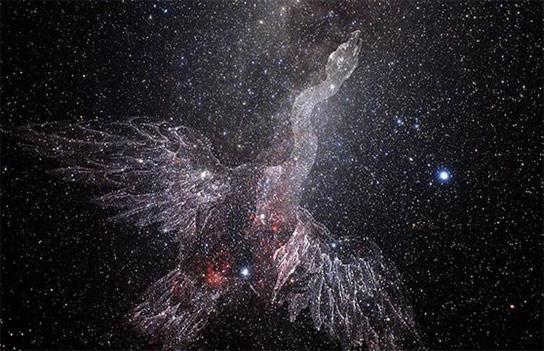
Constellation of the Swan
In later periods, the meaning of the constellation of the Swan was often associated with religious symbolism. In maps from the 17th century and beyond, the image of the crucified Christ would frequently replace the depiction of the Swan. This connection was reinforced by the presence of the Northern Cross asterism, which was easily visible from Earth. The association between the Northern Cross and the crucifixion can be traced back to earlier texts, such as the treatise by St. Gregory of Tours dating back to 592. In this treatise, the Great Cross is described as being situated between the stars Delphinus and Lyra, corresponding to the letters alpha and omega, respectively. This alignment of symbols echoes a passage from the book of Revelation, in which the risen Christ refers to himself as Alpha and Omega, the beginning and the end.
The stunning beauty of stellar space never fails to capture the attention and intrigue the minds of people. In ancient times, the wisest among us were compelled to seek explanations for this magnificent spectacle. The constellation of the Swan serves as a prime example of how the ancient desire to comprehend the unfathomable cosmos found expression in poetry and storytelling. Without the legends and myths that conveyed the perspectives of our ancestors, our knowledge of these celestial wonders would be significantly diminished.





